- Home
- ~ Camino Primitivo (The Original Way)
- Day Thirteen, Lavacolla to Santiago de Compostela
Jump to Camino Primitivo Stages
Day Thirteen on the Camino Primitivo, Final Steps from Lavacolla to Santiago de Compostela, 10 Kilometers (6.21 Miles)
Our day thirteen on the Camino Primitivo was our final day to experience all the emotions that seemed to present themselves to us as we walked our final steps into Santiago de Compostela.
"Man is a creature who walks in two worlds and traces upon the walls of his cave the wonders and the nightmare experiences of his spiritual pilgrimage." ~ Morris West
Yes, the above quote depicted how I felt on this day of our Camino! I felt like I was walking in two worlds.
As our minds inevitably thought about the end of our pilgrimage, and the "What next?" questions arose, our minds still tried to stay in the present, that wondrous liminal space, far separate from the "real" world!
Day Thirteen, Camino Primitivo Maps and Stats
Here is the Google interactive map for the final day thirteen on our Camino Primitivo, with only 10 kilometers left to go. Lavacolla was our starting point, just west of the airport.
There are so many services in these final kilometers. I placed accommodations on the map, along the way, but only albergues in Santiago de Compostela. If you want to divert from the albergue experience upon reaching Santiago, click here for reservations.
It is most important to have a reservation, to ensure that you have a bed, especially during high season and holidays! Many non-walking pilgrims come to this holy city and if you are walking, it would be unfortunate if you had difficulty finding a bed. Most of the private albergues will also take reservations!
The giant albergues near SdC are the 80-bed municipal Albergue De Peregrinos Residencia San Lázaro, just inside the city limits and right along the Way, the municipal Albergue de Peregrinos de Monte do Gozo, with 400 beds and the private Albergue Benvido Monte do Gozo, with hundreds of beds, both on the Monte de Gozo, about 5.0 km before town.
Here is the elevation profile for the day. We had one somewhat significant hill left to climb at the beginning of the day, of less than 100 meters (320 feet) and then, it was mostly all downhill from there into Santiago de Compostela.
Camino Primitivo EBook Guide
Take a look at our Camino Primitivo eBook Guide, for you to download to your personal device for comfortable reading offline and without ads. Our eBook is packed with detailed information and photos, including a *new* bonus side trip, to the incredible and unusual Santa Eulalia de Bóveda temple, the mostly ingnored neolithic standing stones at Montouto and finally, the often-missed, but lovely alternative to the Hospitales Route, (which is gorgeous too), the route to take in the event of inclement weather, along the Río Nisón for 6.8 kilometers! Our eBook Guide is unique because we also entertain and immerse you with our story! Click here for more info OR BUY NOW.
Jump to Camino Primitivo Stages
The Journey, Day Thirteen on the Camino Primitivo
Picking up the Camino after the crosswalk over the N-634, in the center of Lavacolla, we walked south along this quiet paved lane, pictured below.
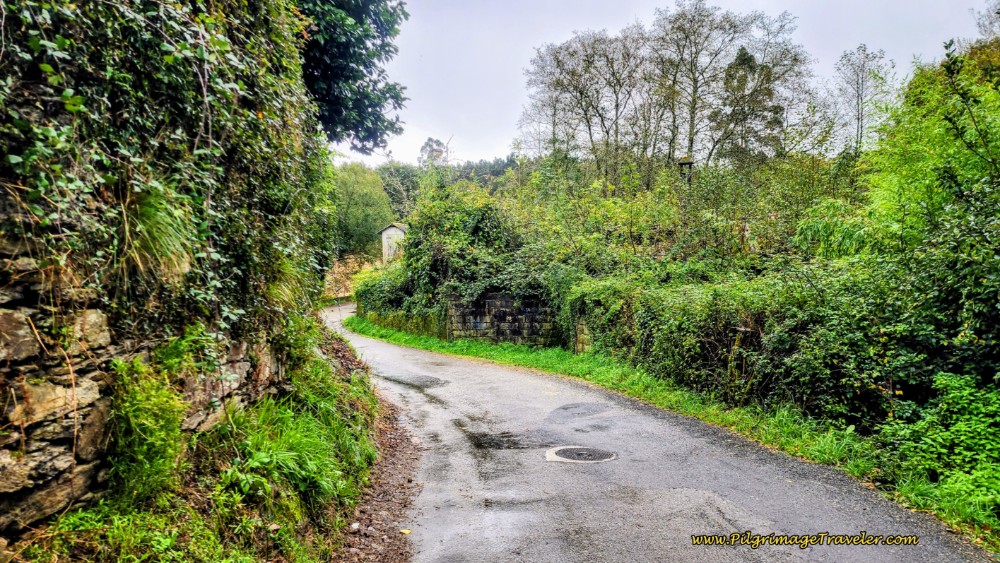 Leave Lavacolla on Quiet Lane
Leave Lavacolla on Quiet LaneOnly about 100 meters later, we came to the Rio Sionlla, turned right at the waymark, and followed the river and crossed it on a footbridge.
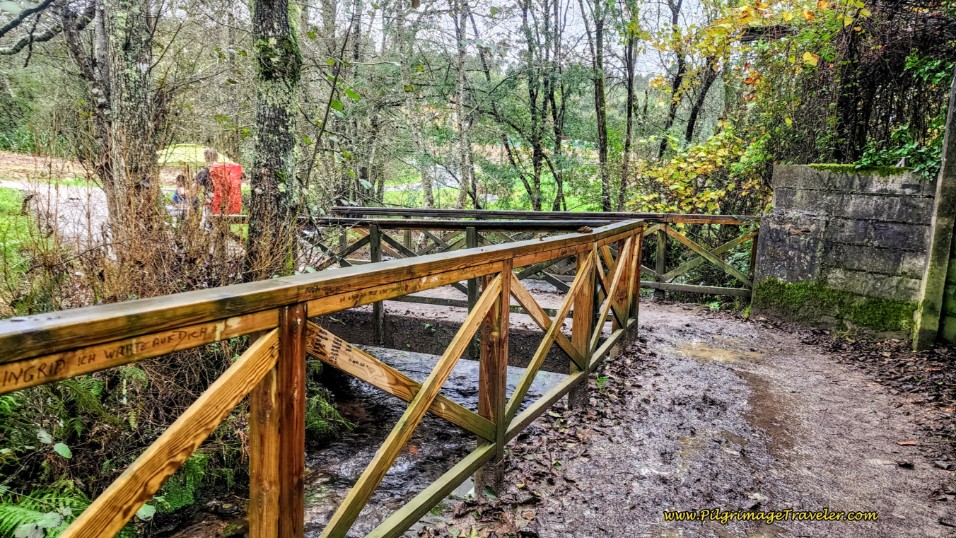 Cross the Río Sionlla on a Footbridge
Cross the Río Sionlla on a FootbridgeAh - after crossing the bridge, there is plenty of space to wander down to the banks of the river! I wish I had known about this spot the prior evening of day twelve, as I would have come here, waded in the "river" and sat for a while in prayer and contemplation.
The modern plaza and bridge in Lavacolla are nice, but I was hoping to find just a spot like this, to contemplate the significance of this river where the medieval pilgrims would bathe before entering the holy city. If you are reading this before your day’s journey, you will have the opportunity to do so, even if you do not stop for the night in Lavacolla.
After crossing the river, you will begin the 2.0 kilometer long climb for this stage. A few steps beyond the footbridge, come to a T-intersection and turn right to continue walking on the lane from Lavacolla. Stay to the left at the next intersection a few meters later. You will remain on this paved lane that meanders through the countryside for the next full kilometer, crossing another river along the way, enroute to the next town of Vilamaior after 1.2 kilometers.
As you enter the town of Vilamaior, walk by a very long concrete “barn” on your left. I could hear animals, I think cows, kicking around in there!
When you arrive in the center of town at a T-intersection, turn right. However, the private Albergue O Fervello is on the left after a few meters. Continue through town on the narrow road, and after the long wall you see in the photo, below, you will encounter on the right side, the Casa de Amancio, a casa rural with a wonderful looking restaurant and bar.
 High Walls on the Exit from Vilamaior
High Walls on the Exit from VilamaiorThe next kilometer after Vilamaior is quite pleasant and continues the climb. It is around 2.1 kilometers from Lavacolla that the terrain levels out, below, and you have completed the final lengthy climb.
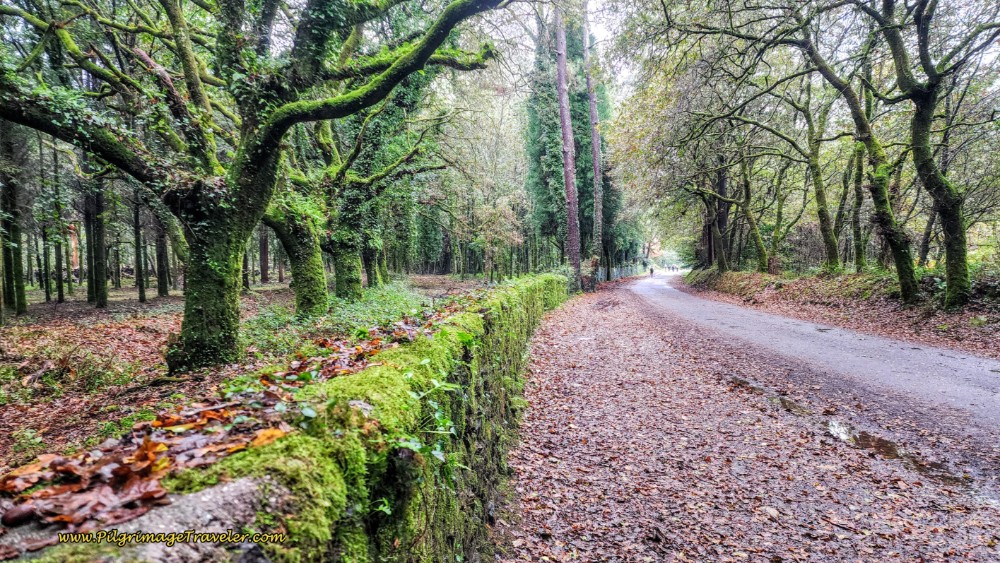 Finishing the Climb from Vilamaior
Finishing the Climb from VilamaiorAbout 700 meters or so after the Camino levels out, come to the distinctive and large Galician TV station, CRTVG, below. This is only one of three industrial buildings you will pass on the way to Santiago, somewhat surprising, for walking into such a large city.
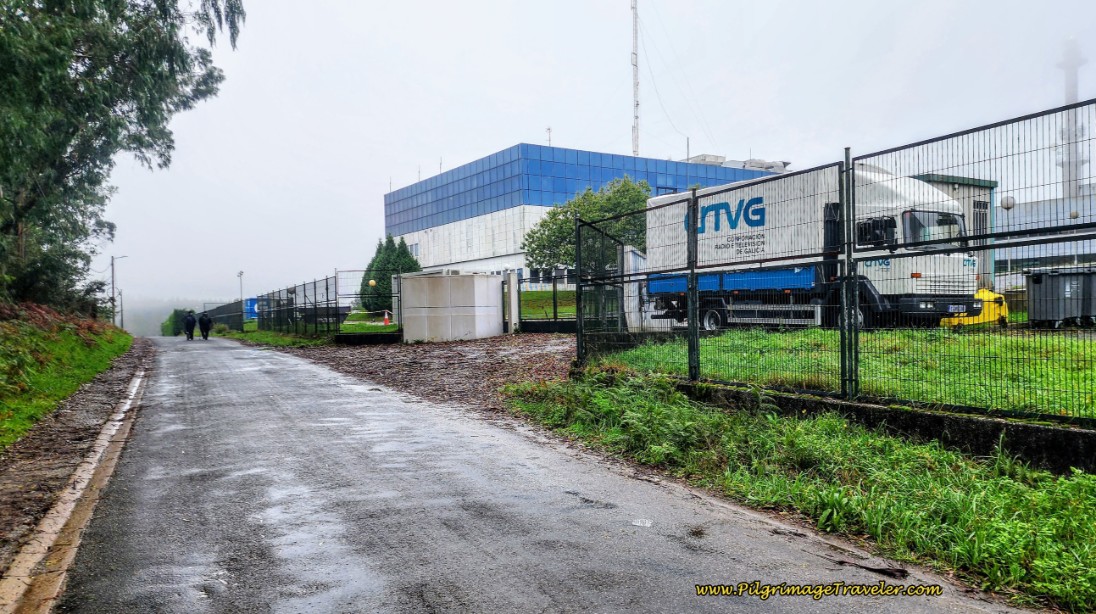 Pass the Galician TV Station
Pass the Galician TV Station250 meters past the TV station, the Camino passes the second industrial building of the construction company, Madeiras Ramos Moreira. And immediately upon passing this long building, the Camino comes to a T-intersection. It turns left here, by the Camping Peregrino San Marcus, with a souvenir shop, snack bar and tent sites, if you are carrying your own tent. It is after about 3.5 kilometers from Lavacolla.
After passing by the camping area, less than 200 meters later, the Camino turns to the right onto another long, straight, paved road below, the Calle Lagoa. You can see that after a short walk down the hill there is another small hill to climb up. You can also see that when these photos were taken, the rain was significant! It did not change the amount of pilgrims on the Way!
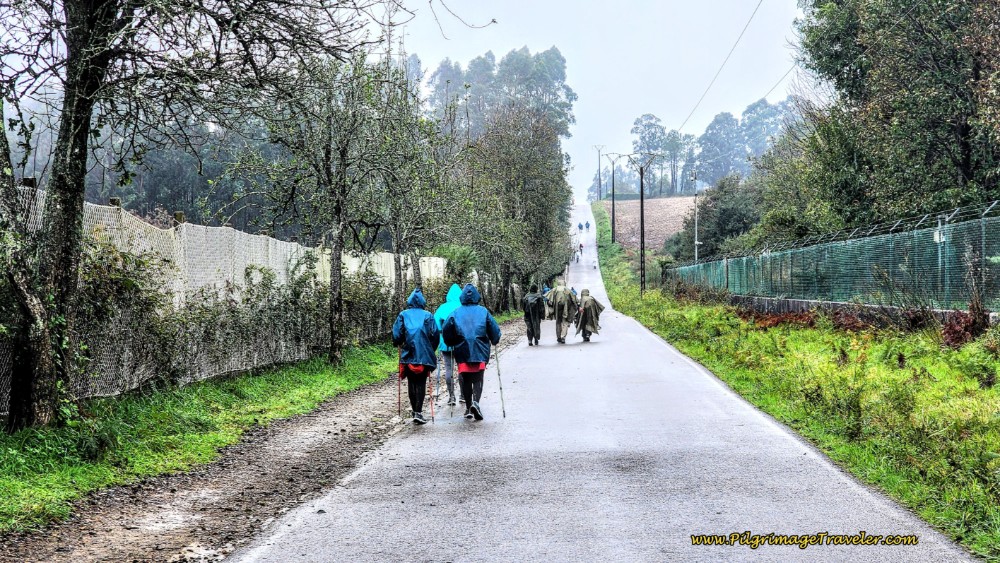 Pilgrims Along the Calle Lagoa
Pilgrims Along the Calle LagoaAfter topping the hill, walk by a crane and machinery company on your right, called Gruas Norte, but it is high-walled protecting your view from it.
After passing the Gruas Norte, and taking a strong S-turn in the road, the countryside becomes more urban-looking, below. Next, come to a T-intersection and turn to the right by the red house in the photo, onto the Rúa do Coto dos Olmos, toward the next town of San Marcos.
 Toward San Marcos
Toward San Marcos100 meters later, the 5.530 kilometer Camino waymark directs you to turn left onto the Rúa de San Marcos. If you keep straight instead, there is the Hotel Akelarre at the next intersection in San Marcos if you wish to stay here. On this corner, the Café A Calzada is available if you need a break.
From this left turn, you will be walking up a hill continuing along the Rúa de San Marcos and through town. Rich and I were at peace as we walked through the hamlet of San Marcos. We talked and reflected quite a bit on our journey and its effect on us. It was so easy to be grateful on this day thirteen of our Camino Primitivo, with Santiago de Compostela almost within sight.
After about 1/2 kilometer along the Rúa de San Marcos, you arrive at an intersection and the 5.080 kilometer waymark, below. You are now entering a famous park called the Monte do Gozo, the "Mount of Joy." It is said that on this hill, the pilgrims, who could see the towers of the Cathedral for the first time, would fall down in rapture and joy! I can just imagine it!
 Toward the Monte do Gozo
Toward the Monte do GozoIt is about 130 meters beyond the 5k waymark, continuing the last bit of the climb from San Marcos, when at the top of the hill you will come to the cute little Chapel of San Marcos, below. You are about 5.3 kilometers from Lavacolla when you arrive here.
If you turn to the left by the front of the chapel, and onto a nice gravel path, this is one of the ways to get to the giant municipal Albergue de Peregrinos de Monte do Gozo and the equally giant Albergue Benvido Monte do Gozo. Just follow the signs and a few meters later, turn to the right and walk down the hill. The municipal albergue is first, then the private, farther along, and at the bottom of the hill.
This path also leads you up and to the left, to a panoramic viewpoint, where you can fall down in rapture at the first sight of the cathedral towers! There used to be a monument here at the viewpoint, commemorating the visit of Pope John Paul II in August of 1993 for World Youth Day, but now there is absolutely nothing on this hilltop.
I actually believe the viewing of the cathedral towers for the first time is best seen along the path just beyond the chapel, a few meters farther, but below the hilltop. The photo, below, is of Rich and me with the best view of the cathedral and its towers in the background!
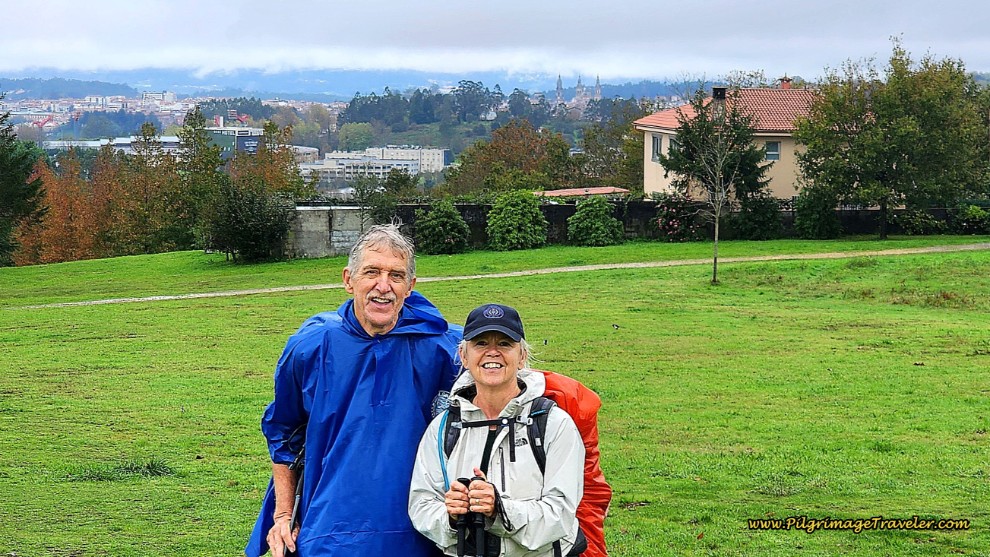 Pilgrimage Travelers and Cathedral Spires
Pilgrimage Travelers and Cathedral SpiresBut if you make the effort to walk another 1/2 kilometer on the path, south and down the hill on the other side, crossing the Rúa de las Estrelas at the large sign for Monte de Gozo, and following another path up a small hill, you will see the famous monument, the Monumento ao Camiñante pictured next. This is the monument of the two pilgrims, facing the cathedral spires of Santiago de Compostela.
I found this to be a special place and worth the visit! It is a full kilometer off-Camino, to get there and back, but it is another reason to give yourself ample time on this final day into Santiago. Check our map above, for its exact location if you need.
The easiest and fastest way to return to the Camino is via the way you came, going back to the Capilla de San Marcos. From the chapel, the remainder of the Camino requires only about one more hour to complete the final 4.75 kilometers to the cathedral.
From the Capilla de San Marcos walk along the wonderful cobblestone street that now becomes the Rúa do Gozo. A few meters after the chapel, look for the left turn to the municipal albergue, another way to access it directly from this road. Notice the rows and rows of albergue buildings to your left as you walk down the hill. This is a pleasant walk, mostly alongside the street along a path, below.
Jump to Camino Primitivo Stages
Farther downhill, you can find another entrance to the Albergue Benvido Monte do Gozo. We found this private albergue to be pleasant, and chose an ensuite 2-bunk room for four (even though there were only three of us) and it was economical enough that after unloading our packs, and finishing the 5k walk into Santiago, we still had more money left over for the taxi ride back. This is another possible option if the beds in Santiago are tight, or if you prefer a quieter experience. The huge Monte de Gozo albergues, side-by-side really are a city within a city, with a bar, a cafeteria, a restaurant, a laundry, an ATM and an eBike rental shop!
The Hotel Santiago Apóstol and the Gran Hotel Los Abetos are also nearby if you wish for a hotel close to the Camino but outside the city.
When the Rúa do Gozo takes a big bend to the right, leave it for a path straight onwards and several meters later pick up this pedestrian bridge, below.
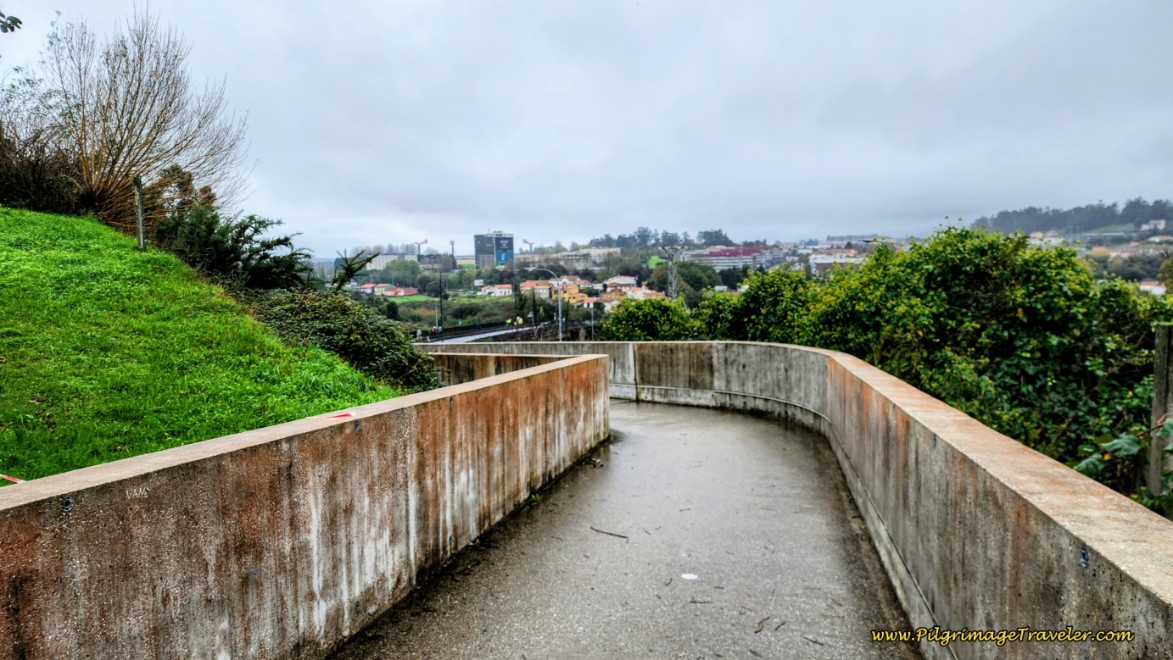 Pedestrian Bridge to the N-634
Pedestrian Bridge to the N-634At the bottom of the pedestrian bridge, you will join the N-634 as it crosses over the AP-9 highway on a protected pedestrian walkway. You will now be walking along the N-634 for the next 1.5 kilometers.
300 meters past the highway bridge, come to a large roundabout. Keep to the left side and on the far side of the roundabout, you have entered the city limits, marked by this sculpture, below, and sign that says "Santiago de Compostela!" We arrived here just after 0900. Most pilgrims will pause here and snap a photograph of their entrance to the city.
The letters of the sign are covered in stickers, I guess a relatively new phenomenon. I was disappointed in this, but we took a photo anyway.
It is just beyond the Santiago sign, at the next smaller roundabout, that the 80-bed municipal Albergue de Peregrinos Residencia San Lázaro can be found, just behind the museum, to the north (right). Look for the signs.
There is also one hotel to the north, the Hotel San Jacobo and two hotels just to the south, the Hotel OCA Puerta del Camino and the Hotel Eurostars San Lázaro. A few more steps onward is the albergue Dream in Santiago.
We actually slowed our steps as we arrived into the city, as if to savor the final moments. We certainly were filled with contentment, that our goal was now in sight. We even stopped for a sort of celebratory café con leche and croissants before entering the main part of the city. It felt appropriate on our day thirteen of the Camino Primitivo.
When I researched facts for this article, I read that it was the tradition for pilgrims to walk the final steps from Monte do Gozo to the Cathedral, barefoot. I was grateful that I was unaware of this tradition, as I don't know how practical this would be on modern city streets!
And as I looked down at the street, I noticed the first bronze waymark shells, pictured next. I believe they started after the 3rd roundabout along the N-634, but I am not certain. It is not important anyway, as there are very visible blue signs everywhere to guide you into the city - unlike other cities along the Caminos. I see these now as mere romantic vestiges along the incredibly popular Camino Francés! But I love them just the same!
After 1.5 kilometers, the Camino leaves the N-634 to turn left onto the Rúa do Valiño. Over the next full kilometer or so, there are many, many private albergues! Along the Rúa do Valiño in the order that you will see them is the Albergue Fin de Camino, a few steps south of the Way, the Albergue Santo Santiago, the Albergue A Fonte de Compostela, as well as the Hotel San Lázaro.
The Rúa do Valiño takes you by a park on the left side, and about 1/3 kilometer later, cross the next intersection and look for a fountain on your left, if you need water. The street now becomes the Rúa das Fontiñas. Along the Rúa das Fontiñas in the next 400 meters is the Albergue Monterry.
Next, the Camino turns to the right onto a street with a median in the center, called the Rúa dos Concheiros and the Albergue Turístico La Credencial is on the corner. The Albergue SCQ, and the Albergue Sixtos no Caminho are only a few more steps down the street.
You will walk along this median street as it takes a big bend to the left and after only 150 meters come out to a large open plaza. Look for the Camino blue signs across the road, the N-550, to continue straight along the Rúa dos Concheiros for the next 350 meters. You will encounter even more albergues, the Albergue Santos, the Albergue La Estrella de Santiago, and the Albergue Porta Real.
When the Rúa dos Concheiros ends at another large open plaza, and the street narrows and becomes the Rúa de San Pedro, the first urban glimpses of the cathedral towers come into focus, see photo below. For us, on our first time through, since we missed this on Monte do Gozo, this was our first glimpse! You can just see a cathedral spire above the pilgrim in the red jacket’s head.
For my husband, Rich, who had not yet been to Santiago de Compostela, it was his moment of joy! (And for me too!) Fueled with our café con leche, we were now eager to get there, and quickened our pace!
As you continue along the Rúa de San Pedro, the street becomes narrower and more quaint, below. You can feel the medieval center getting closer!
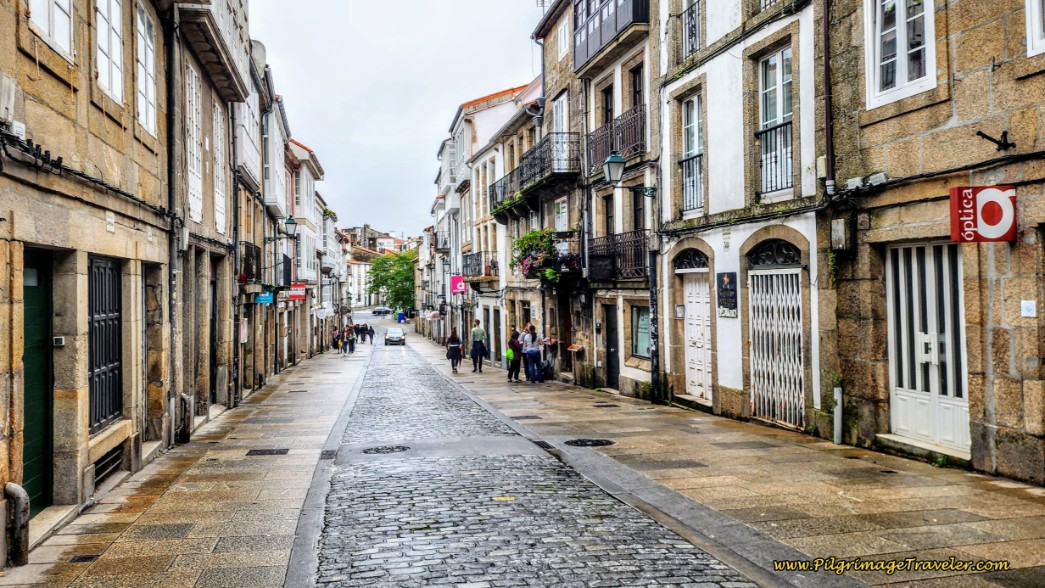 Along the Rúa de San Pedro
Along the Rúa de San PedroSurprisingly there are no albergues through this section. At the end of the Rúa de San Pedro 400 meters later and just before entering the old city at the Porta do Camiño, or the original medieval gate, is a small plaza with park benches and a cruceiro. The Museo de Pobo Galega is just behind it.
From the plaza, cross the Rúa das Rodas into the heart of the city and what would have been walled in the medieval times. Below is the famous portal into the city, the Porta do Camiño. This is where the original walls would have had the gate. We were mere steps from the cathedral. Unless you noticed the sign on the building, you would not even know the significance of this place. What you will notice is that this is now a pedestrian-only street.
Into the heart of the old city now, walk up the hill along the Rúa das Casas Reais for the next 180 meters, passing the Capela de Ánimas where you can only see the steps of the chapel in the photo below.
Come to a T-intersection and turn left onto the very narrow Rúa da Algalia de Arriba. It can be tricky through this section, so either follow other pilgrims or look for the street sign, and after a few more steps you will see this fountain, pictured below, in the Praza de Cervantes. Head for the street following the colonnade in front of the Abanca, which you can clearly see in the photo, and you are on your final steps to the cathedral!
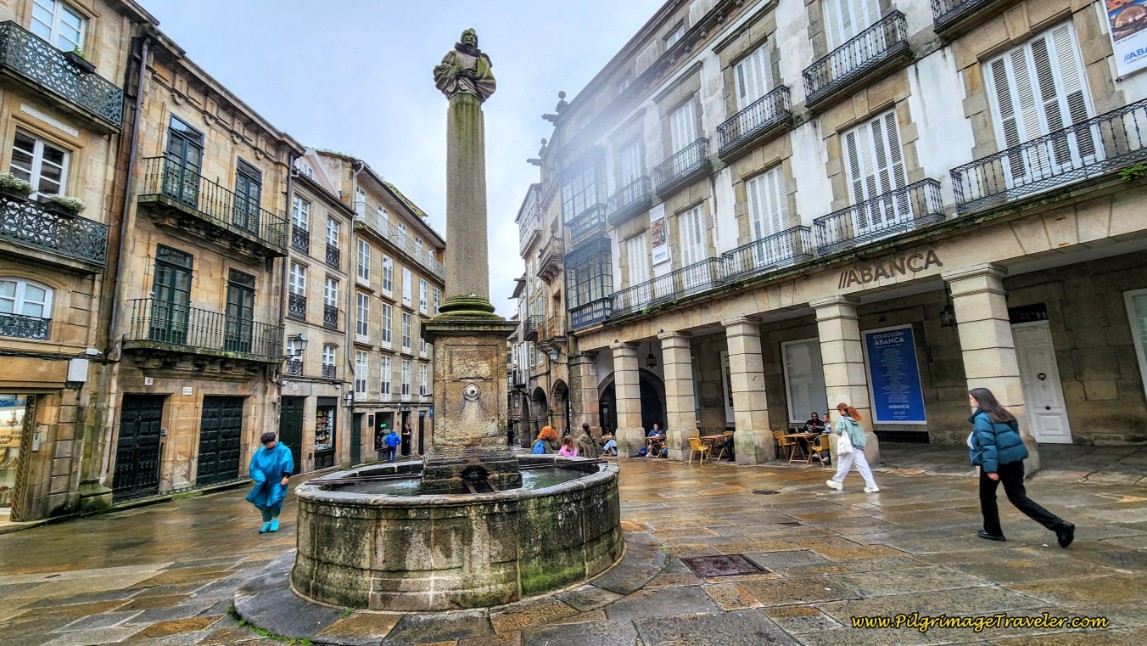 Fountain in the Praza de Cervantes
Fountain in the Praza de CervantesThe street past the Praza de Cervantes is the Rúa da Acibechería, full of tourist shops along the next 100 meters, and then you break out into the Praza de Inmaculata, below.
This plaza is on the north side of the Santiago de Compostela cathedral, and is where all foot traffic exits the cathedral. It is a bustling place!
All that remains of your Camino are the steps beyond this plaza, and through the famous tunnel with the bagpiper, that you can see in the photo above, at the white building. Just follow the throng.
We had finally made it to the main Praza do Obradoiro, for the traditional victory shot!
Shortly after arriving on the praza, we stumbled into Mattias. Despite his foot problems, he had made it. We contacted Glyvia, and she was also due to arrive shortly after us.
We checked into and stayed at the historic former monastery of the Hospedería de San Martín Pinario, which is well worth it, but there are many accommodations available in the city of Santiago de Compostela. We usually prefer to stay in a hotel once we arrive in Santiago, and have stayed in the Casa Celsa - Barbantes, the Pensión Paz de Agra, and the Pensión Residencia Fornos. They are all comfortable, clean and economical. You can search for many others by clicking here for booking.com.
There are also many albergues in the city, two right along the French way just before the cathedral, the Albergue The Last Stamp and the Albergue Azabache. In addition, to the north of the cathedral there is the Blanco Albergue, the Albergue Linares, the Albergue Alda O Fogar de Teodomiro and the Albergue Santiago KM-O. And finally, there is the huge Albergue Seminario Menor to the south as well as the Mundoalbergue.
We all gathered together for lunch, after the noon mass, at my favorite, the Casa Manolo for a nice family reunion. The food as always, was delicious.
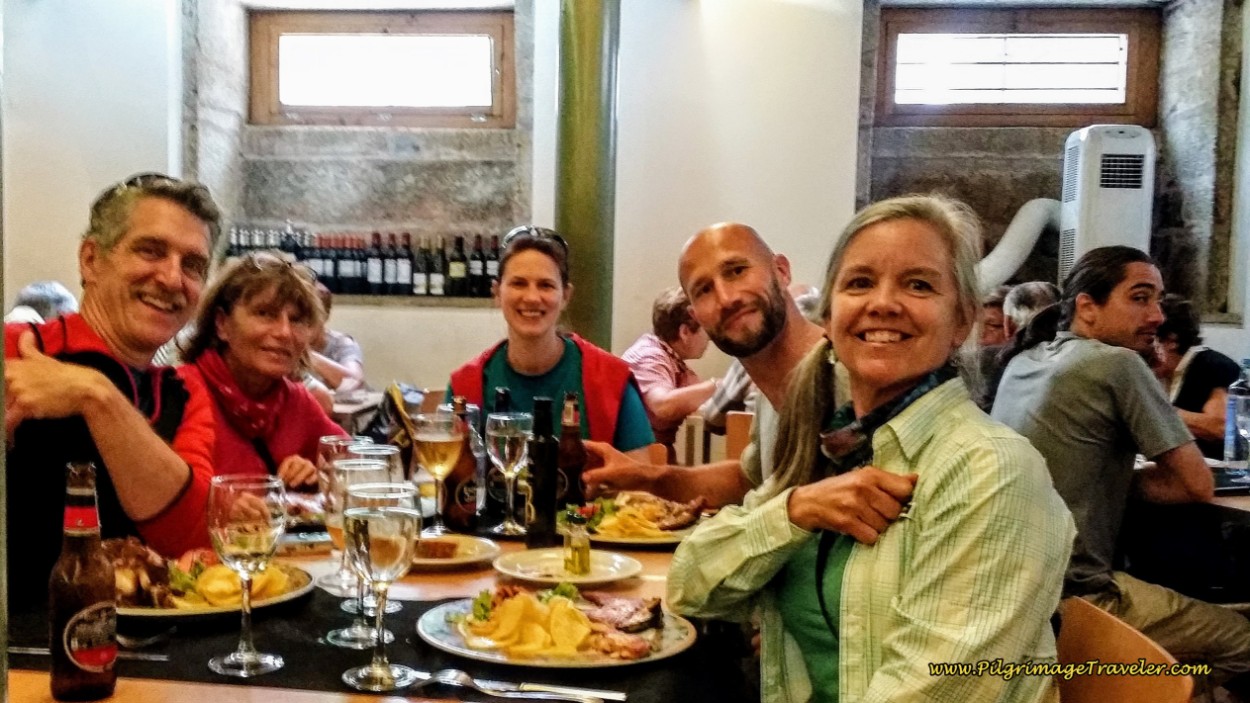 Rich, Glyvia, Saskia, Mattias, and Elle
Rich, Glyvia, Saskia, Mattias, and ElleWe heard that at the pilgrim's mass every Friday at 7:30 p.m., it was guaranteed that the botafumeiro would swing. How lucky that we had arrived on a Friday! (This has since changed. Click here for the current schedule. In addition to this schedule, you may be lucky enough to be at a mass after a large tourist group pays to see it swing).
At that time, we were still able to secure seats in the section reserved for pilgrims by getting there one hour early. (Sadly, this is no longer true because there are no special seats for pilgrims anymore.) We had front and center seats! Nowadays you must arrive very early to even get a seat!
And indeed, we saw the botafumeiro swing! Click here to see more of this one-of-a-kind experience. It was an amazing wrap for our final, day thirteen on the Camino Primitivo.
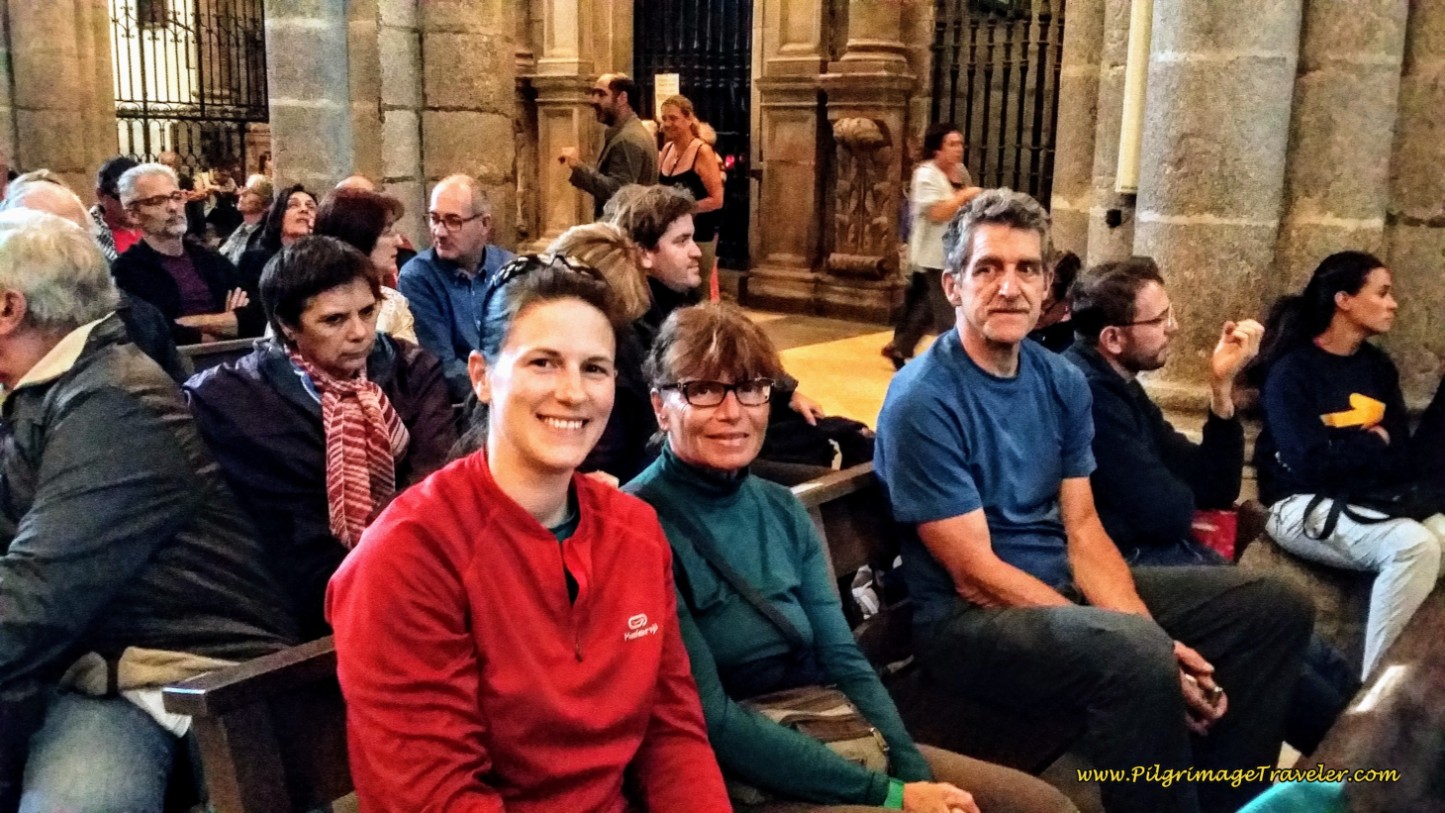 Saskia, Glyvia and Rich in the Cathedral of Santiago de Compostela
Saskia, Glyvia and Rich in the Cathedral of Santiago de CompostelaReflections on Day Thirteen of our Camino Primitivo
The final steps on the Camino Primitivo truly felt like I had one foot in one world and one foot in another. The day was fraught with many emotions that we had difficulty identifying. Was it relief? Was it joy? Was it simply satisfaction that we did it, that it was over?
Rich says that for him, his primary emotion was sadness, because now we had to go back to the "to do" list and all it entailed. I felt an immediate emotional response to this for it rang so true in my own heart. Life would no longer be so simple again.
I didn't want to go back to what we could see in our future at hand, the constant business of having a thousand things to do. We hoped and wanted to get over that now, and pace things better. We wanted a world in which there was no hurry, no reason to constantly be forcing ourselves to "do" stuff.
We were hopeful that we would take this lesson home - the simplicity of the Camino, being in the moment, and the Presence of God in it all. It was so wonderful to forget everything, forget all of our concerns, forget our responsibilities and duties, and even forget the date - if only for thirteen days!
It was easy for us, and very quickly we had slipped into the present and simple way of being at the start of our Camino Primitivo and throughout all the days. We also knew too well how easy it would be to slip back into the busyness and craziness. We were feeling these emotions already, and we weren't even home.
We also reflected on the angst and difficulty of travel for the medieval pilgrims and their great hope for healing and absolution; this seeking that had gone on for centuries as they journeyed to Santiago!
Just speaking of this truth made me feel emotional because I felt the energy, the pain and the suffering they must have gone through in order to do the Camino. It must have been unbelievable. Some of them didn't make it. Some died along the way ~ or the way back.
The most amazing thing in my mind is not only did the medieval pilgrims need to get to Santiago, but they had to figure out how to get back! We modern pilgrims don't get this, as we can just hop on a bus, plane or train to get back because the goal is merely Santiago de Compostela!
Think how anticlimactic it would be for the modern pilgrim, for us to have to walk all the way back from where we started! I would be SO discouraged if I had to walk all the way back to Oviedo! Most of the medieval pilgrims came from much, much farther away than merely Oviedo.
All of this pilgrimage history is very interesting to reflect upon; to not lose sight of what has been here for so many years. Most modern pilgrims are here for their own sport and not much more. There is nothing wrong with that, but I just couldn't help reflecting on the dramatic difference between then and now!
We did also feel true joy, there is no doubt, upon our completion of the Original Way and throughout our entire day thirteen on the Camino Primitivo. We did feel real relief, also. We did feel an incredible sense of accomplishment and gratitude to God from deep within our hearts. We did feel a sense of brotherhood for all we met and a spirit of community difficult to match elsewhere.
Yet here we were on our final day and by far, the most overwhelming emotion was one of sadness that our journey was about to end. Already we were dreading going back into the "real world" and all its encumbrances. Reintegrating into life, yet keeping the Camino spirit was the real challenge.
Which of the two worlds is real? Is the pilgrimage traveler one who successfully navigates both worlds? Yes, perhaps, as with the completion of each Camino, perhaps we can see more clearly, more quickly, more easily where we fail to marry our lives with simplicity, community, luminosity, curiosity and Presence to God!
Camino Primitivo EBook Guide
Still thinking about our downloadable, Camino Primitivo eBook Guide? Would a money-back guarantee and free updates for a full year help with your decision? Would it help if we told you that we frequently update our information as we receive it, without the need for publishers and the slow process reprinting of hard copy books, which improves our book's accuracy? Click here for more info OR BUY NOW.
Salutation
May your own day thirteen on your Camino Primitivo be filled with wonder at your many emotions! May you carry with you the hope for completion and absolution, as you need in your own life. May your final steps on your Camino be blessed as you take your lessons learned, and navigate the two worlds with Grace, Love and Presence! Ultreia!
The Camino Primitivo Stages
Please Consider Showing Your Support
Many readers contact me, Elle, to thank me for all the time and care that I have spent creating this informative website. If you have been truly blessed by my efforts, have not purchased an eBook, yet wish to contribute, I am very grateful. Thank-you!
Search This Website:
Follow Me on Pinterest:
Follow Me on Instagram:
Find the Pilgrimage Traveler on Facebook:
Like / Share this page on Facebook:
***All Banners, Amazon, Roamless and Booking.com links on this website are affiliate links. As an Amazon associate and a Booking.com associate, the Pilgrimage Traveler website will earn from qualifying purchases when you click on these links, at no cost to you. We sincerely thank-you as this is a pilgrim-supported website***
PS: Our guide books are of our own creation and we appreciate your purchase of those too!!
Shroud Yourself in Mystery, along the Via de Francesco!
Walk in the Footsteps of St. Francis, and Connect Deeply to the Saint and to Nature in the Marvelous Italian Countryside!
Recent Articles
-
Day One on the Camino Portugués, Lisbon to Alverca do Ribatejo
Apr 15, 25 08:19 PM
Our Day One on the Camino Portugués was much more beautiful and enjoyable than we had heard. -
Hiking the West Highland Way
Apr 11, 25 08:51 PM
Hiking the West Highland Way is a representation of all things Scottish, traversing 96 miles from the lowlands of Milngavie to Ft William, in the highlands. -
Way of St Francis eBook Guide (Via di San Francesco)
Apr 11, 25 08:49 PM
Our Way of St Francis eBook Guide, a digital guidebook is full of current information to assist you in finding your Way. In downloadable, digital, PDF format.
Need suggestions on what to pack for your next pilgrimage? Click Here or on the photo below!
Carbon fiber construction (not aluminum) in a trekking pole makes them ultra lightweight. We like the Z-Pole style from Black Diamond so we can hide our poles in our pack from potential thieves before getting to our albergue! There are many to choose from! (See more of our gear recommendations! )
Gregory BackPack - My Favorite Brand
Do not forget your quick-dry microfiber towel!
Booking.com
My absolute favorite book on how to be a pilgrim:

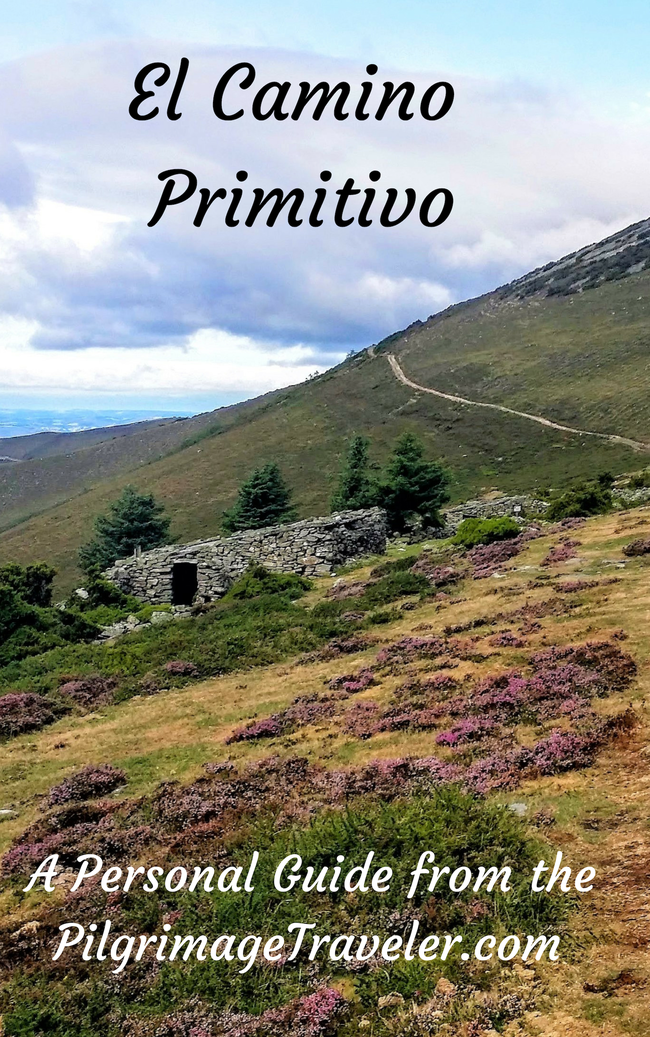
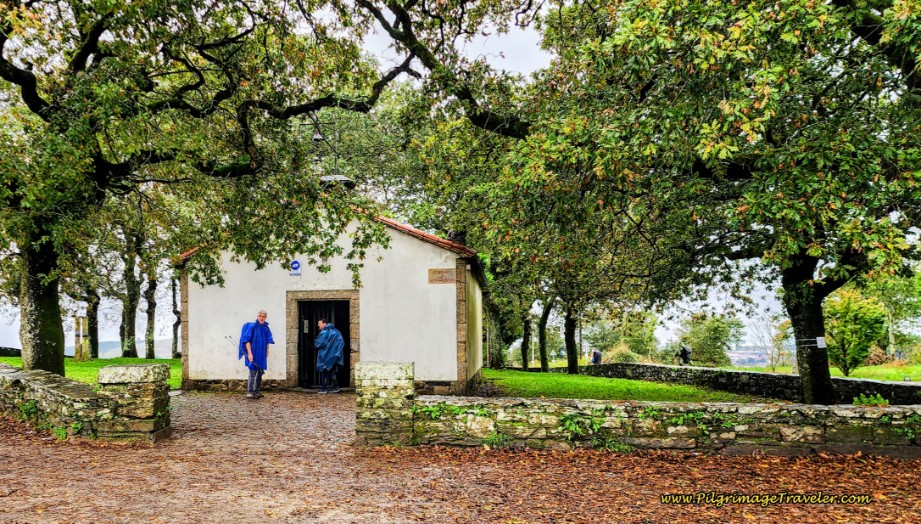
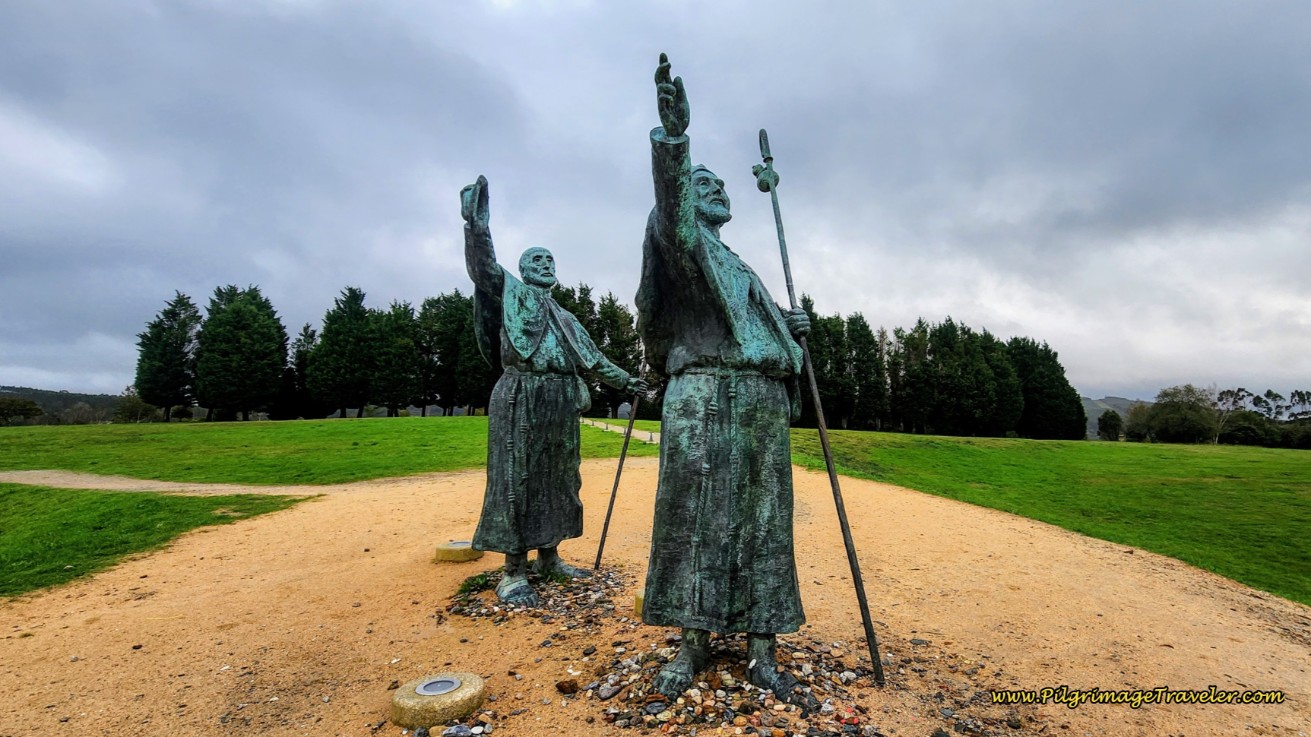



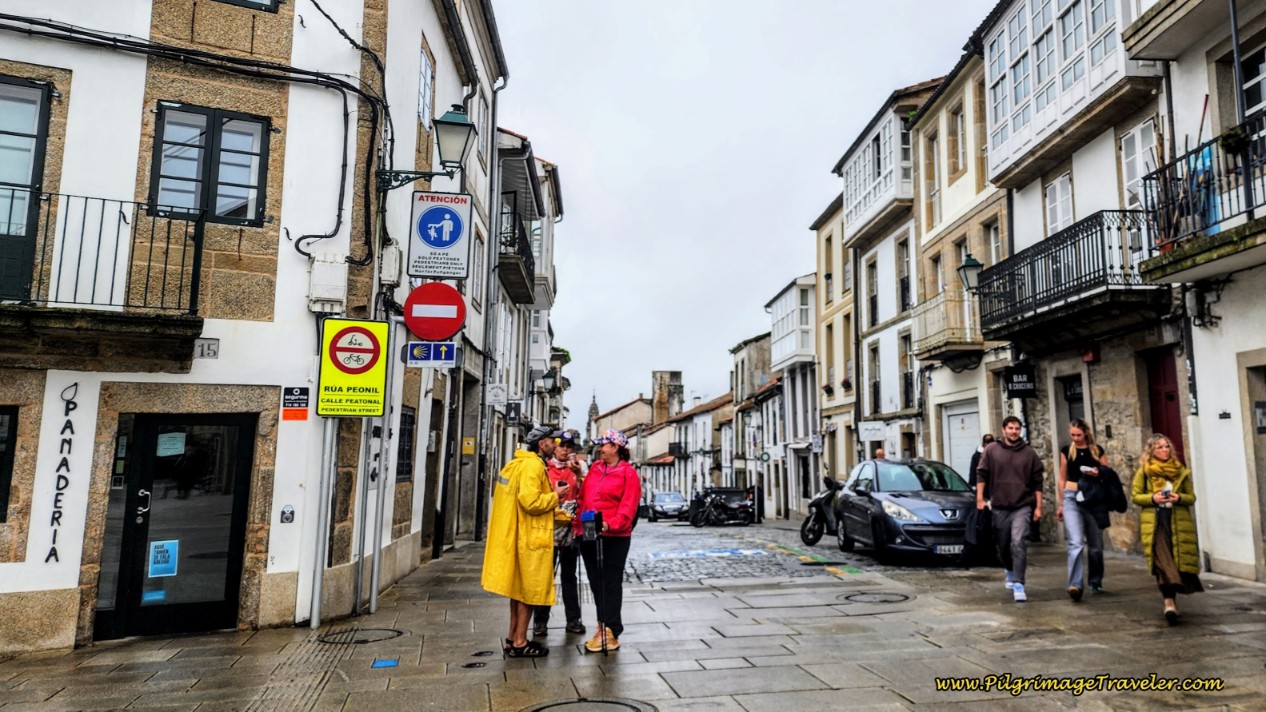

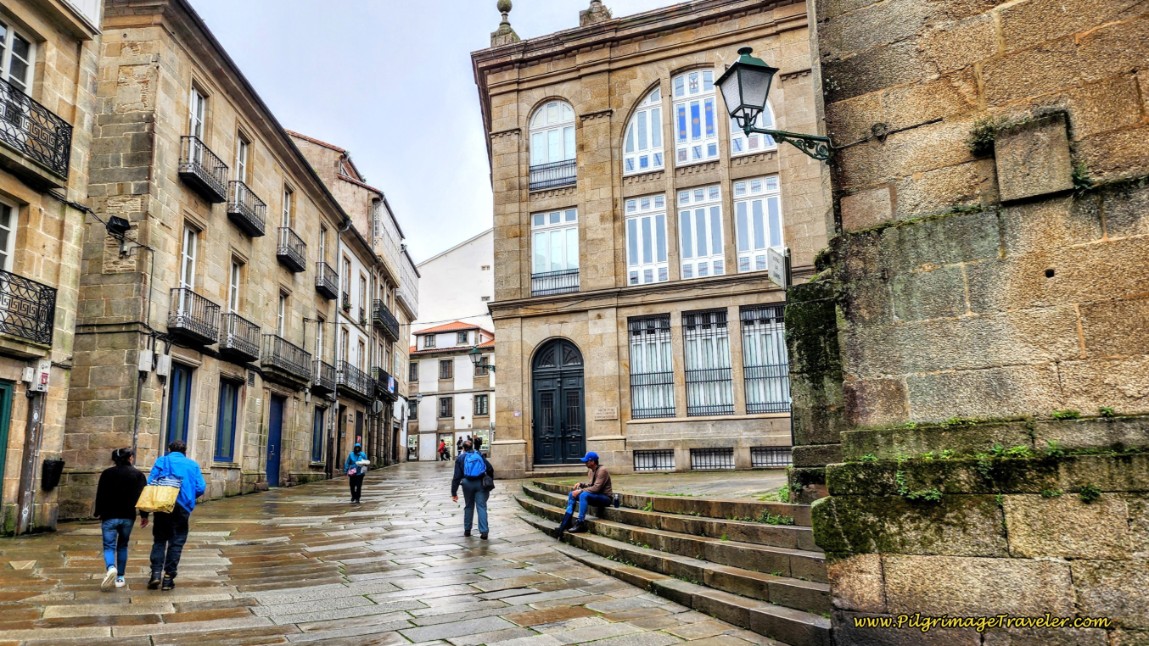
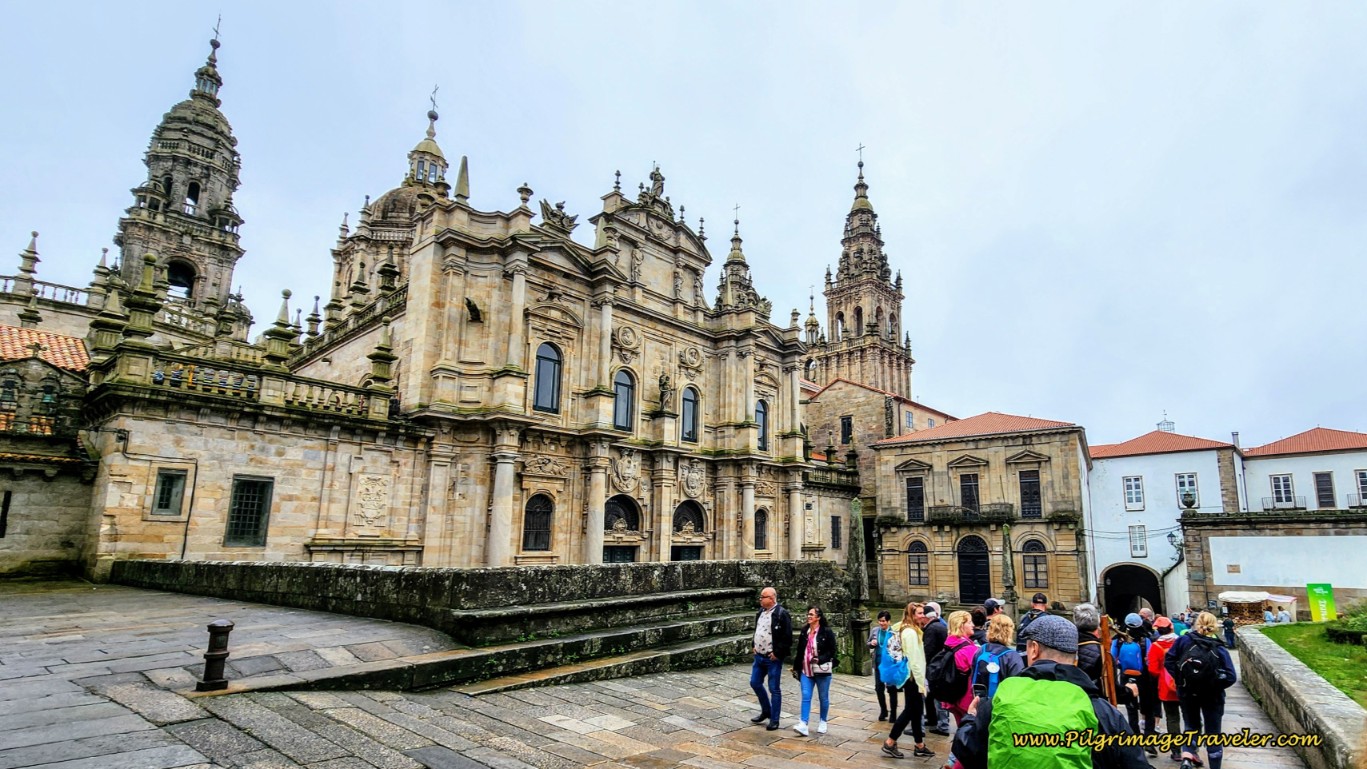
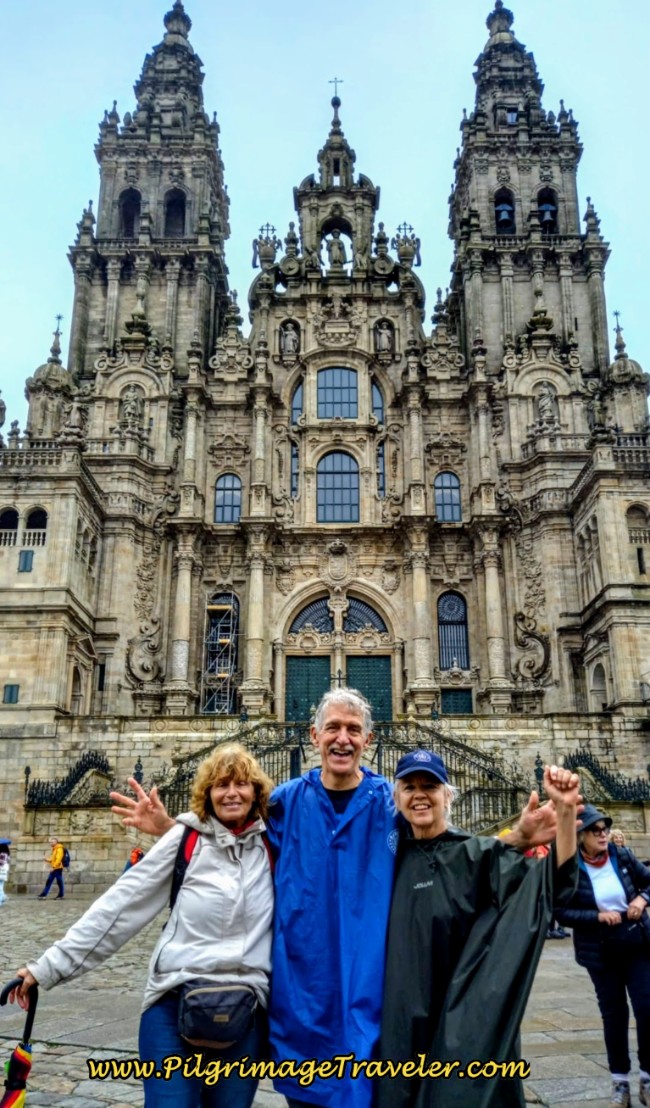
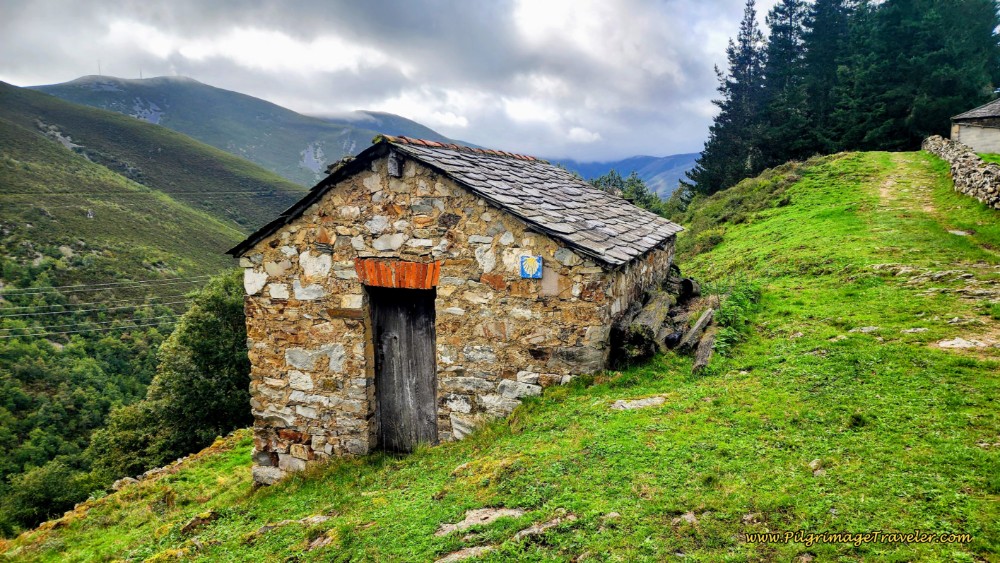
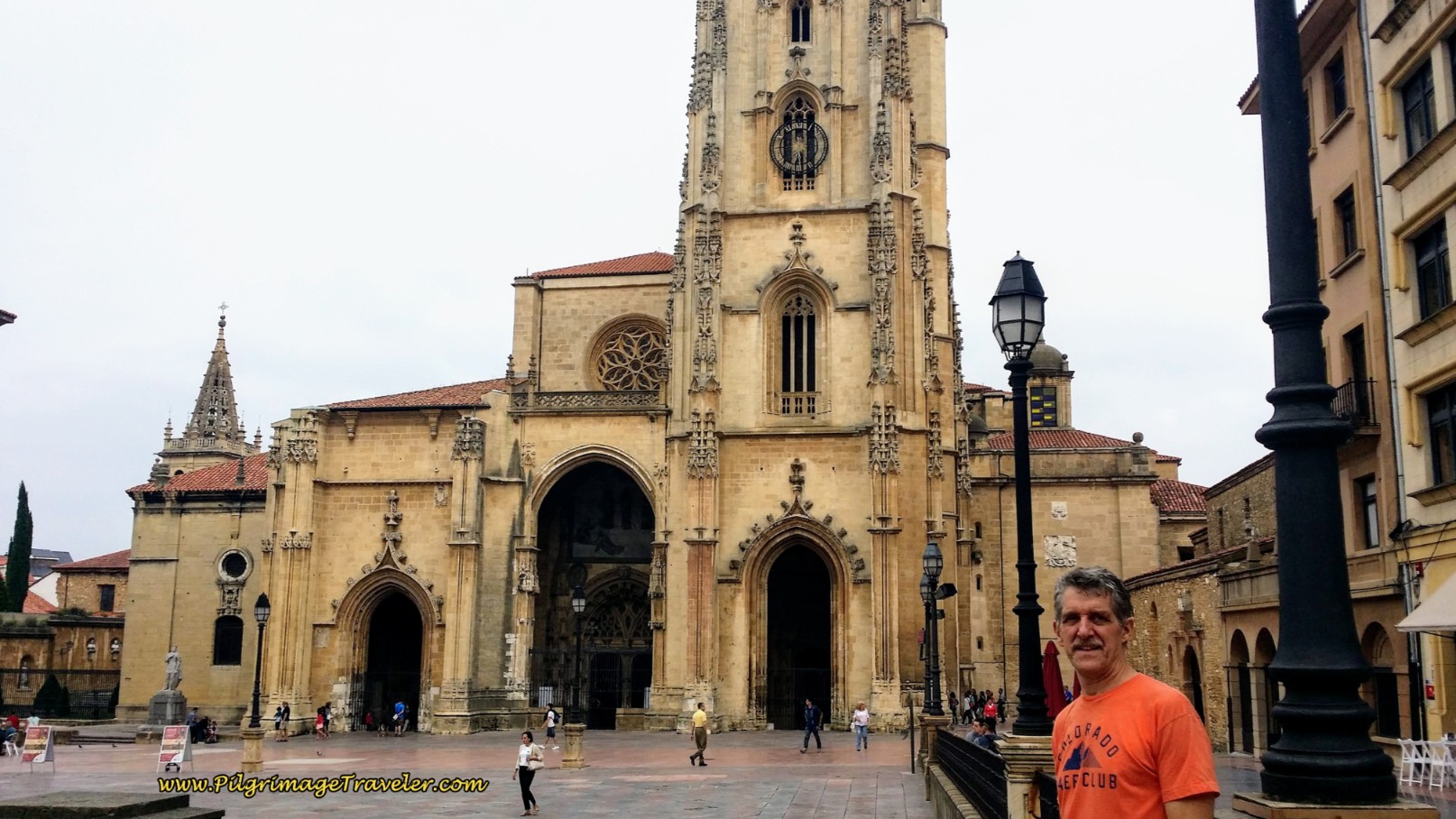
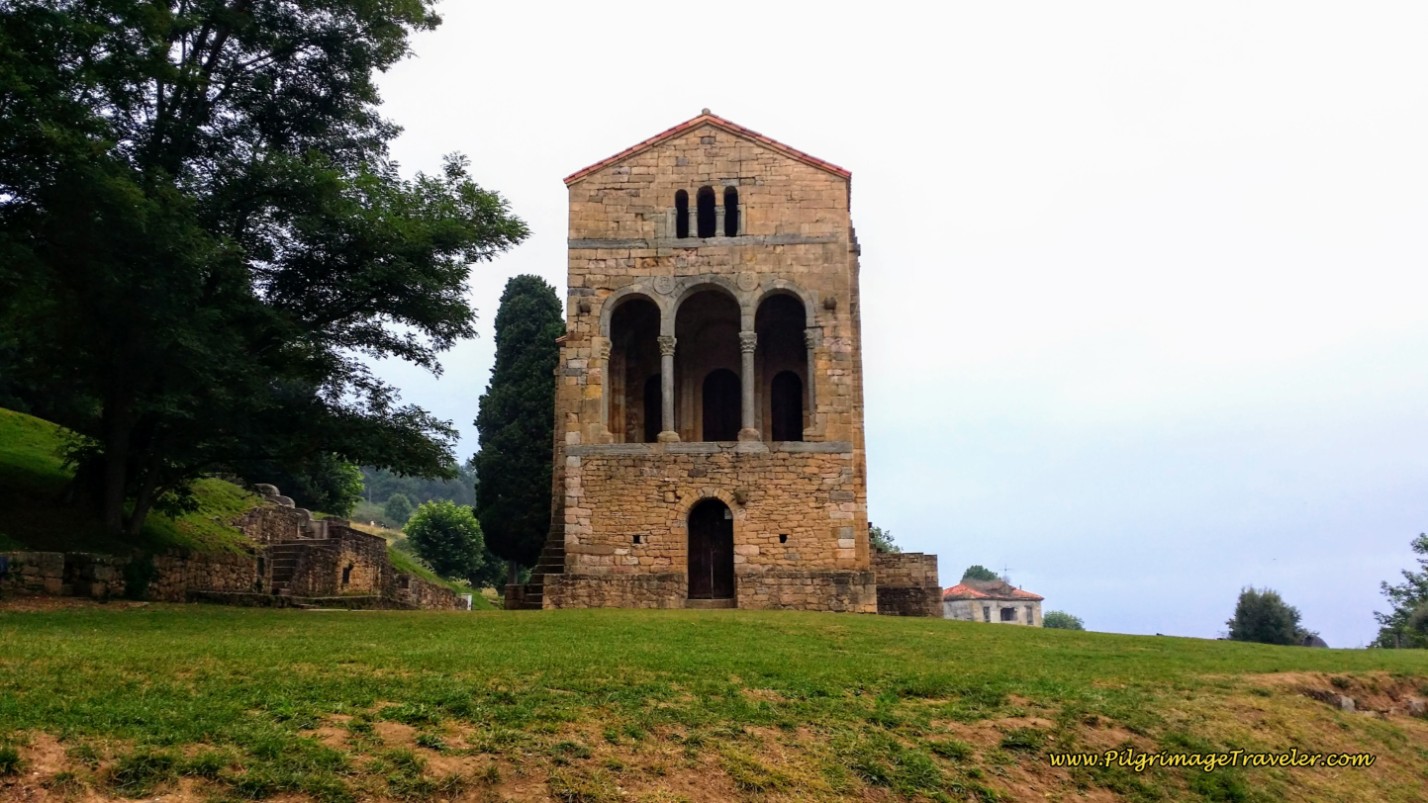
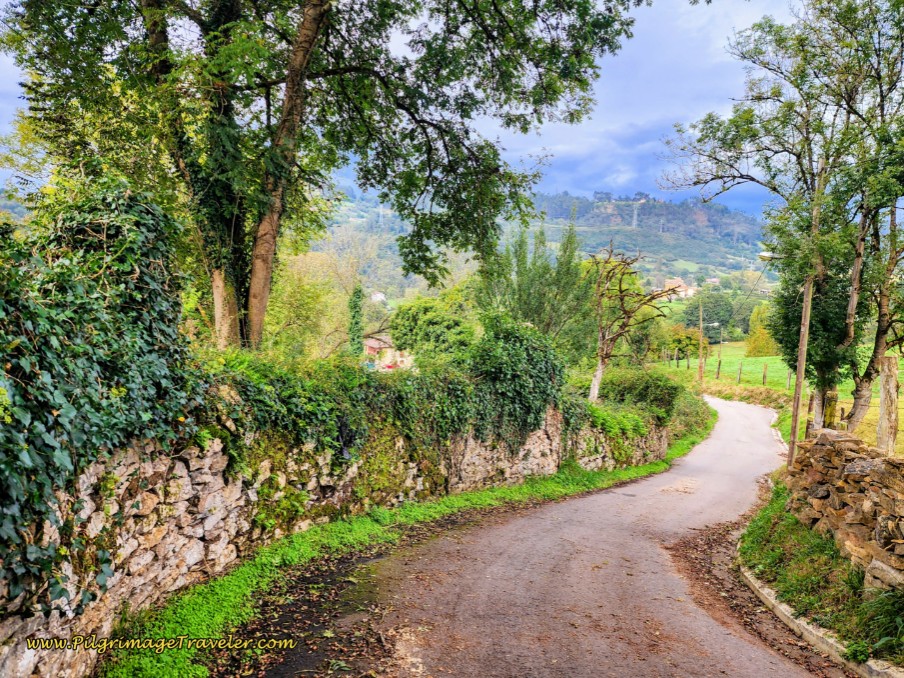
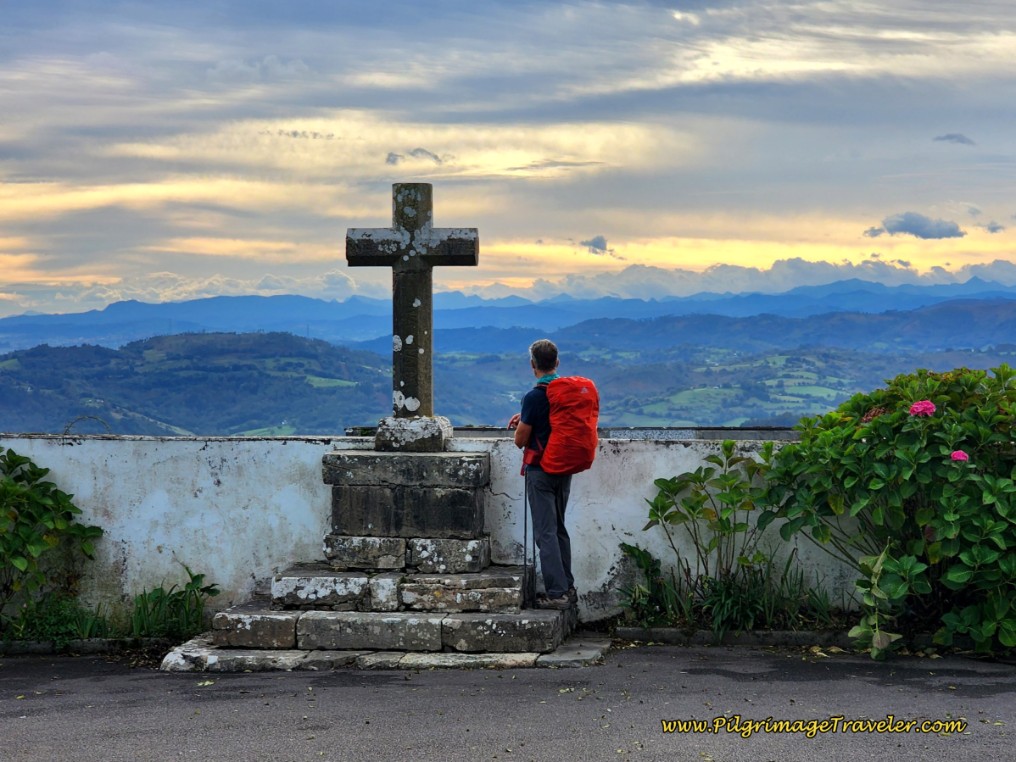
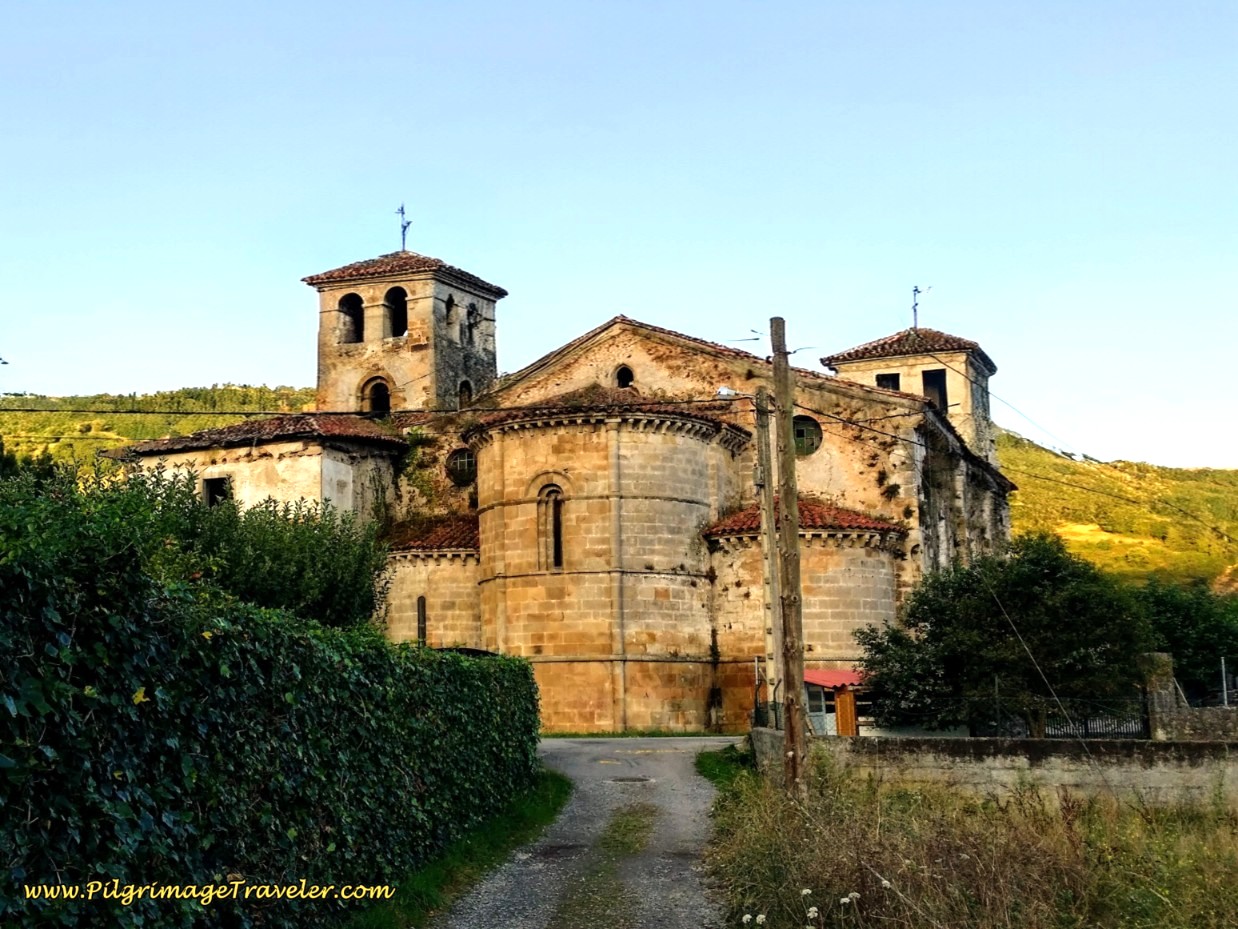
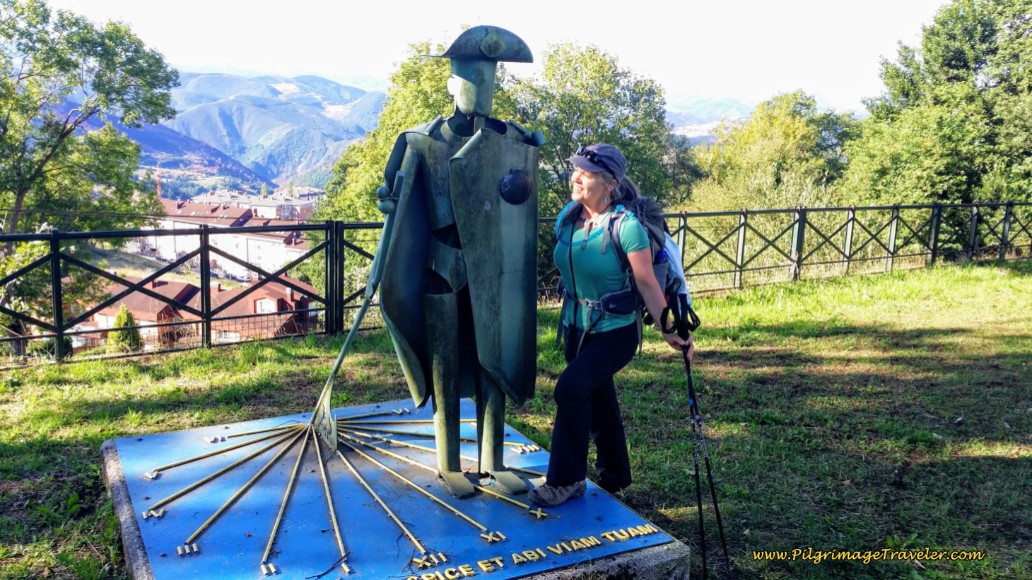
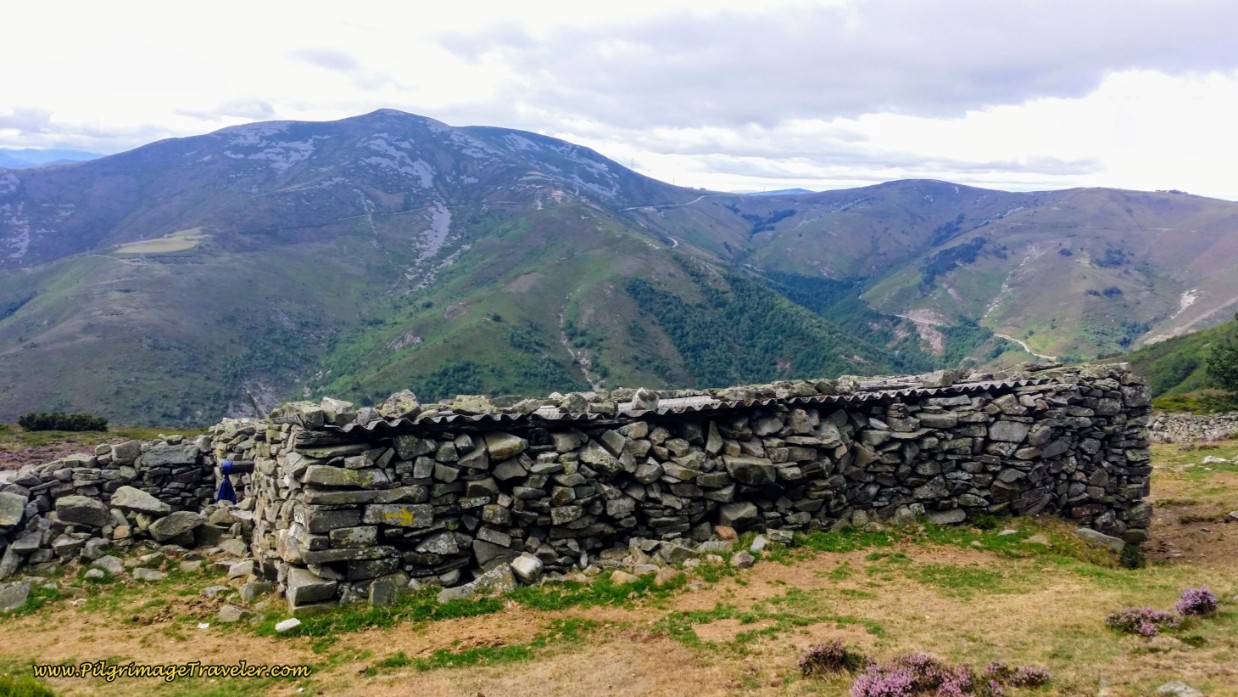
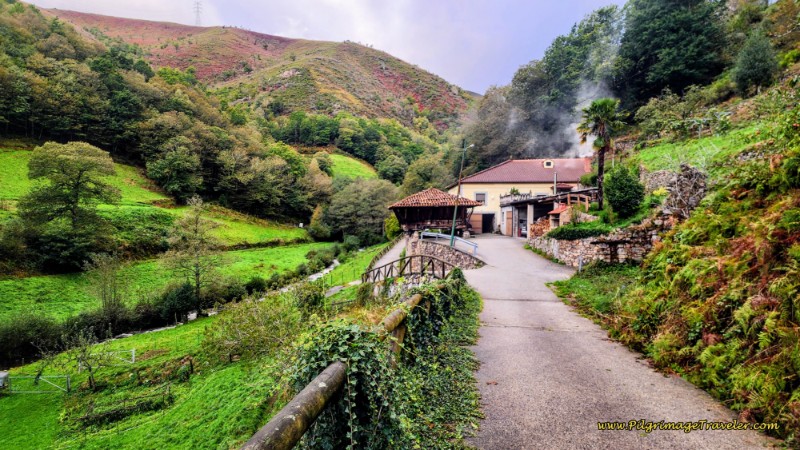
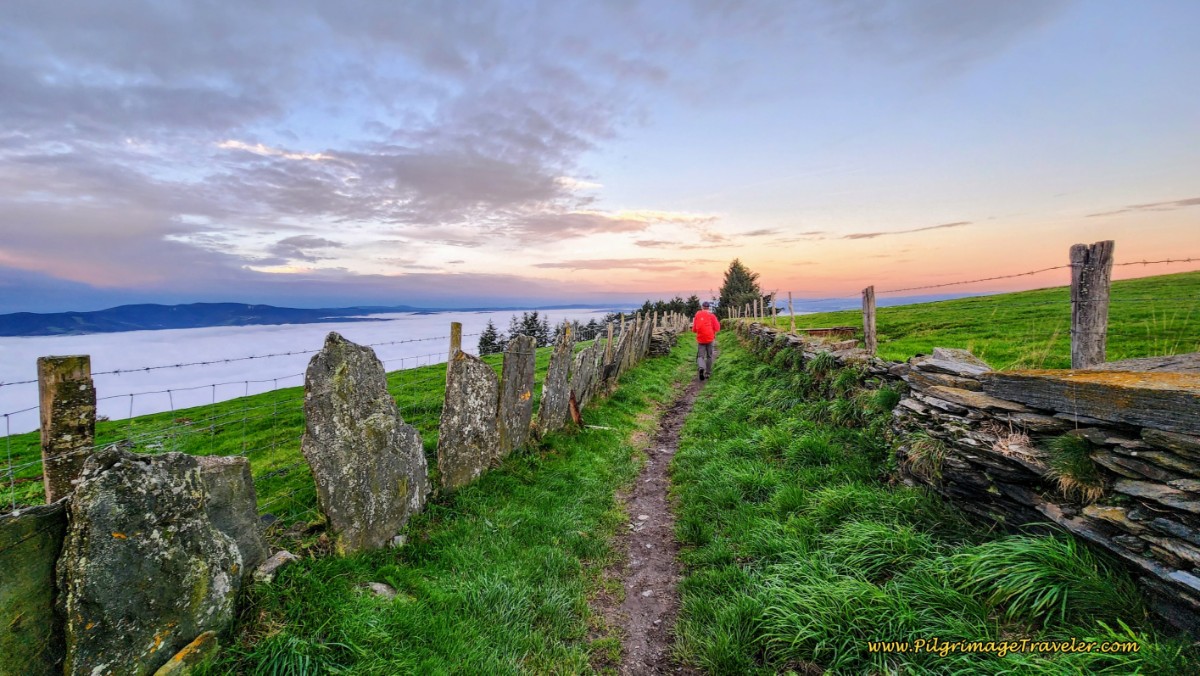
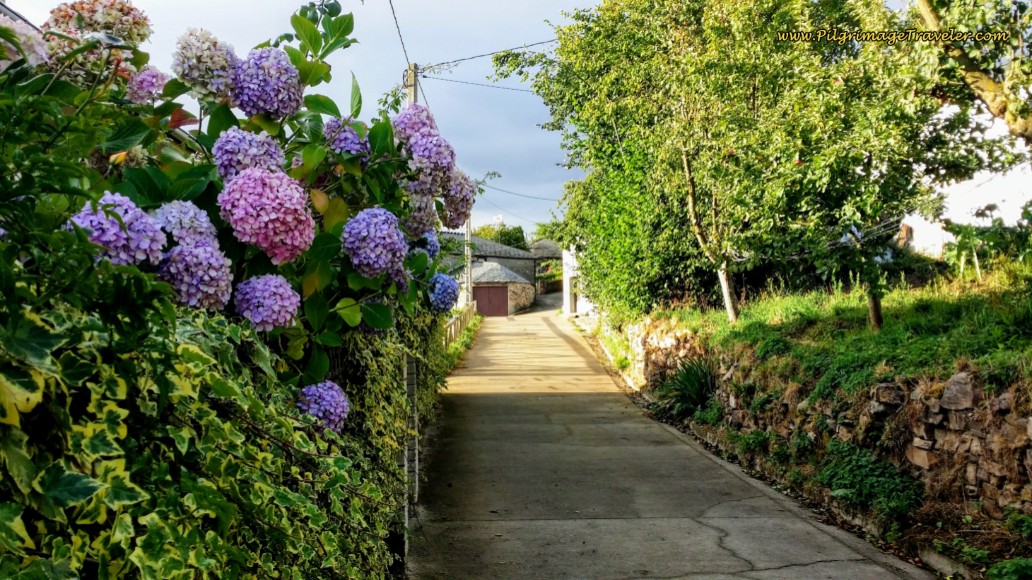
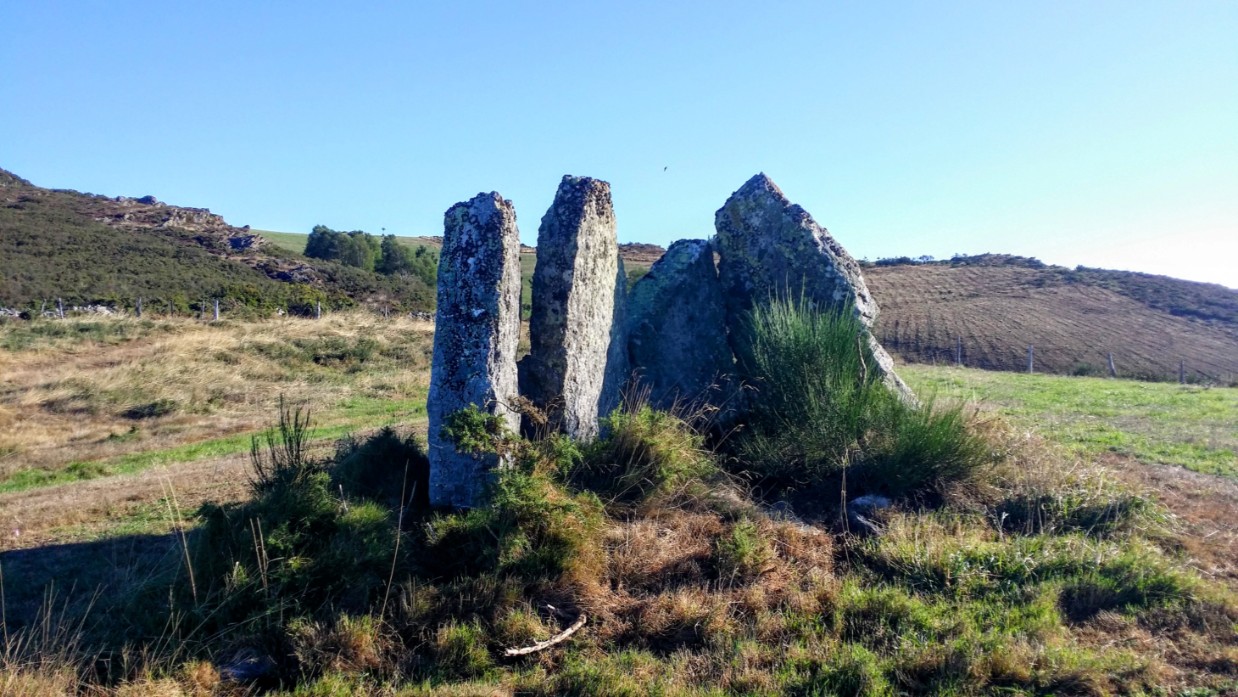
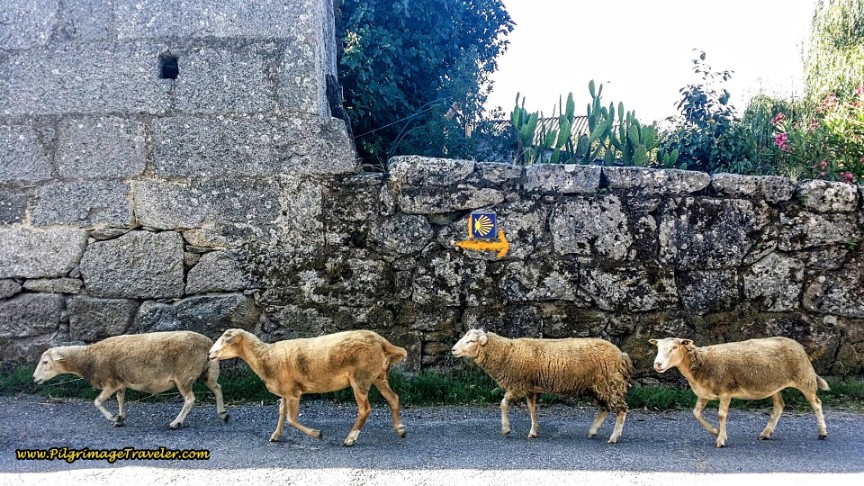
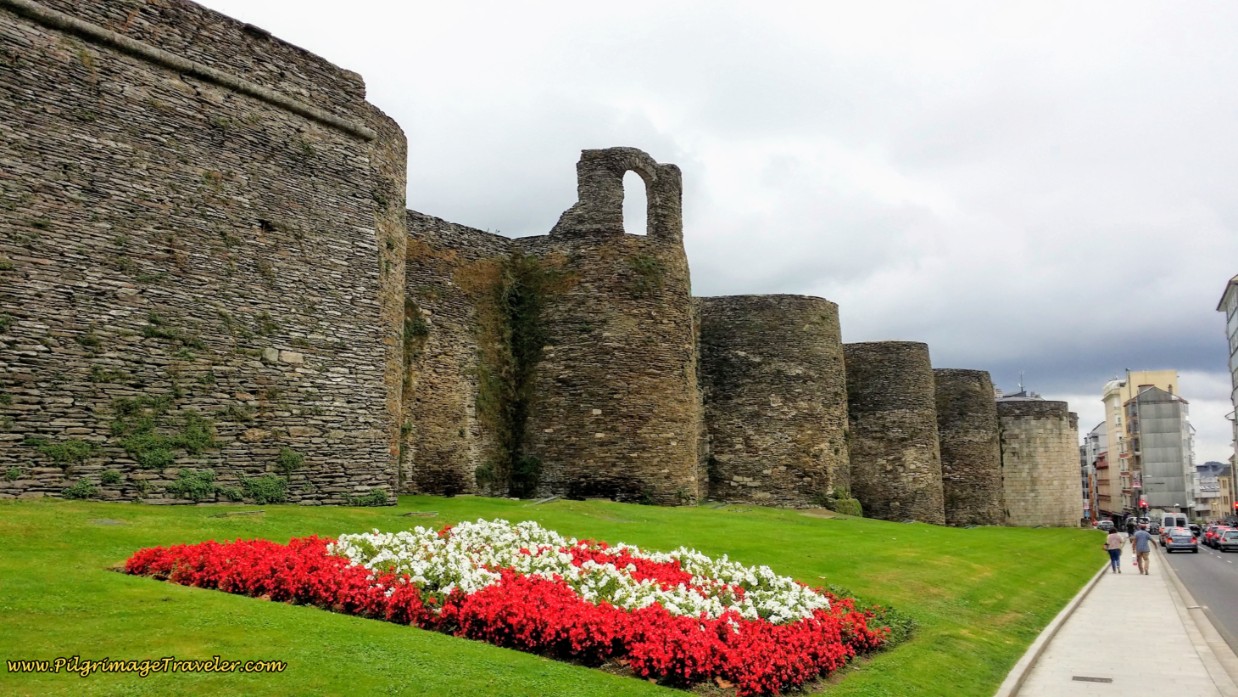
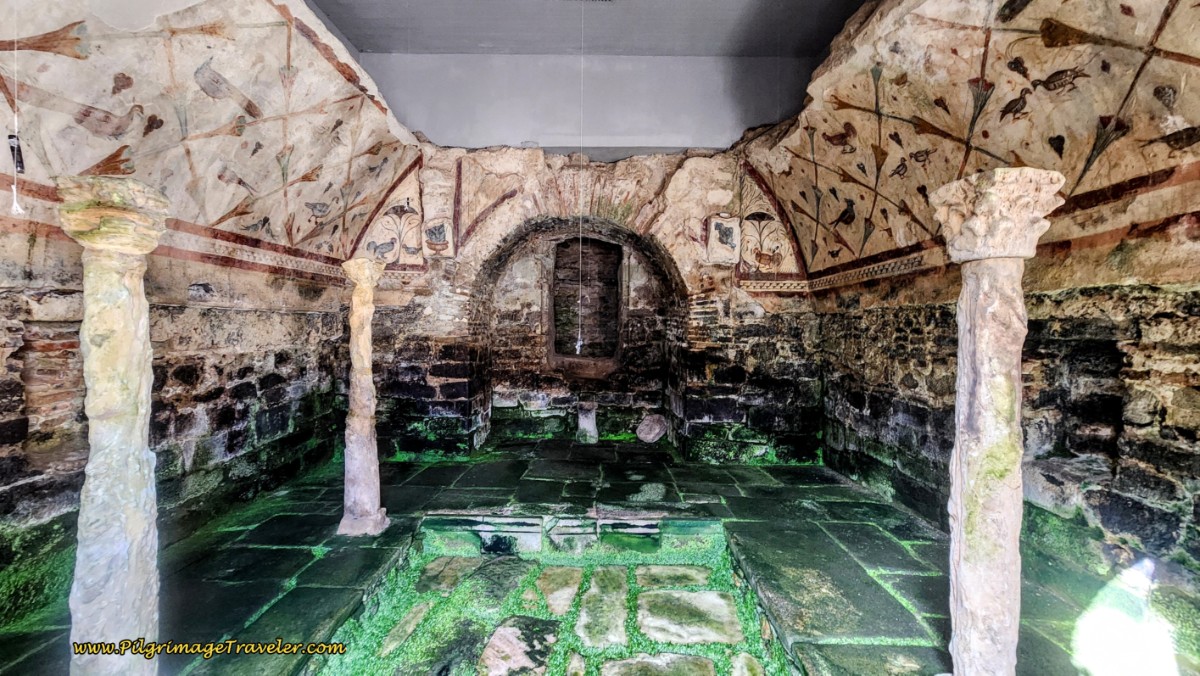
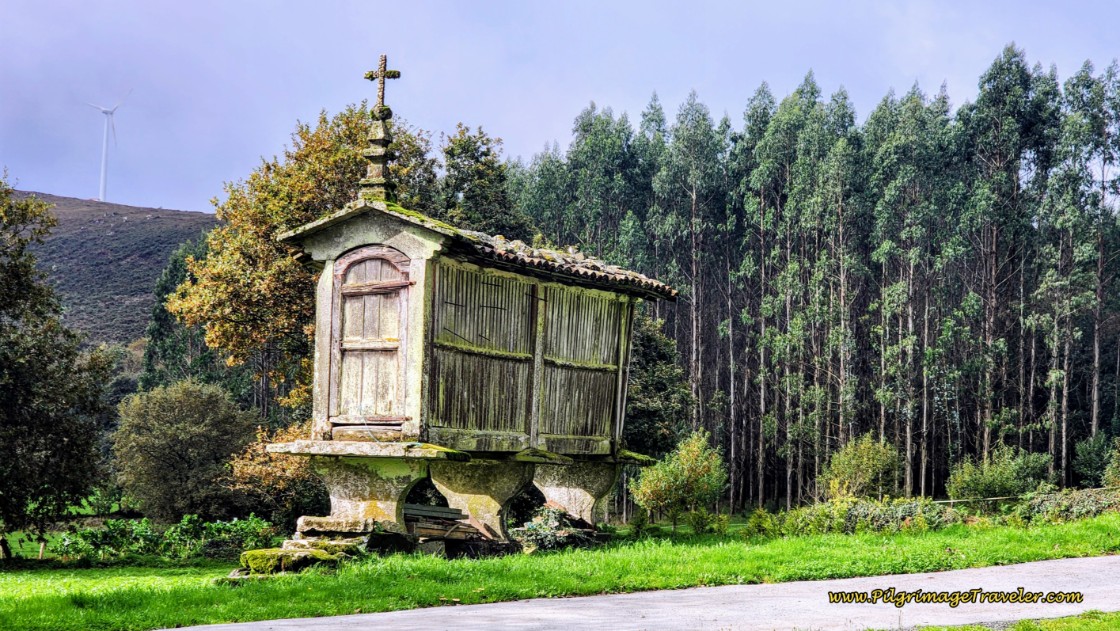
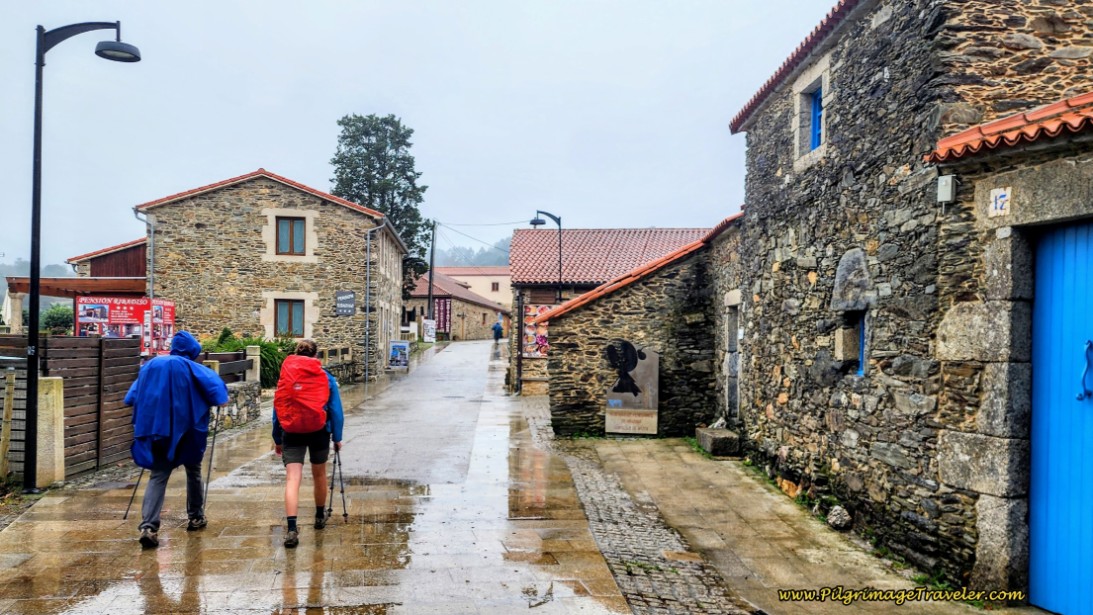
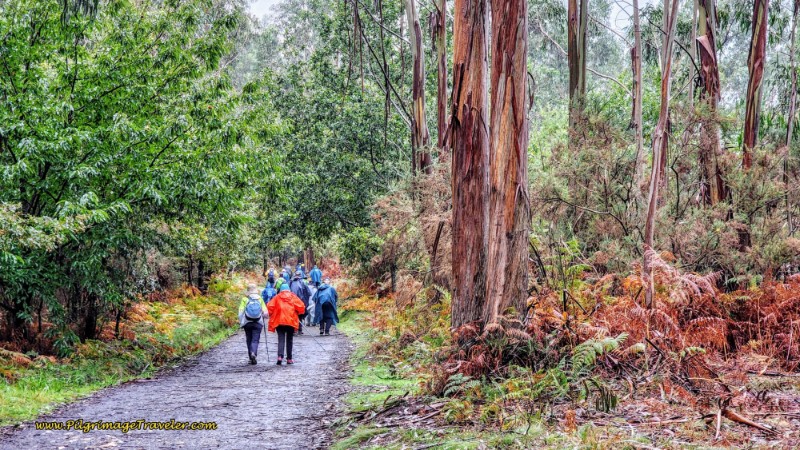
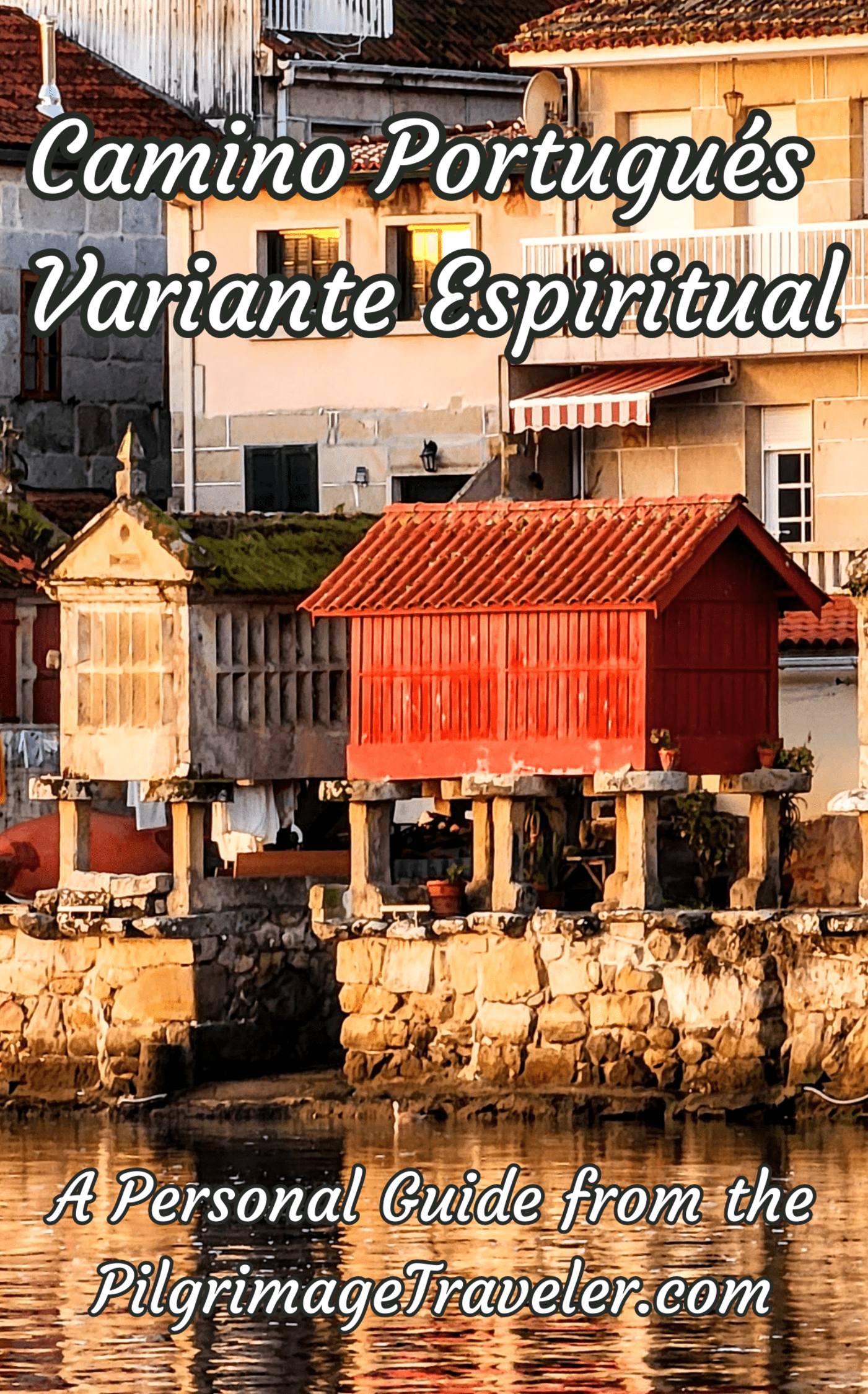
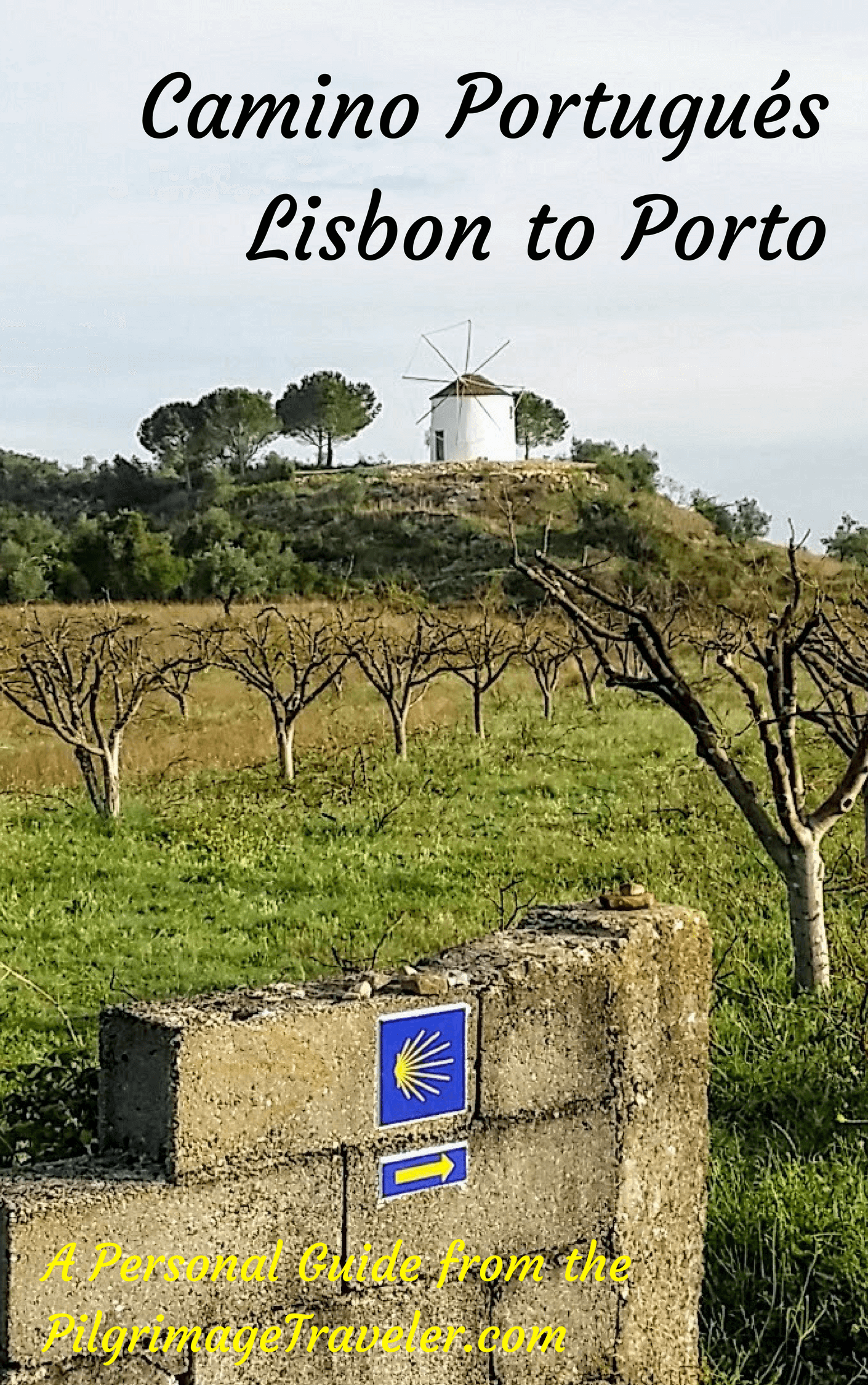
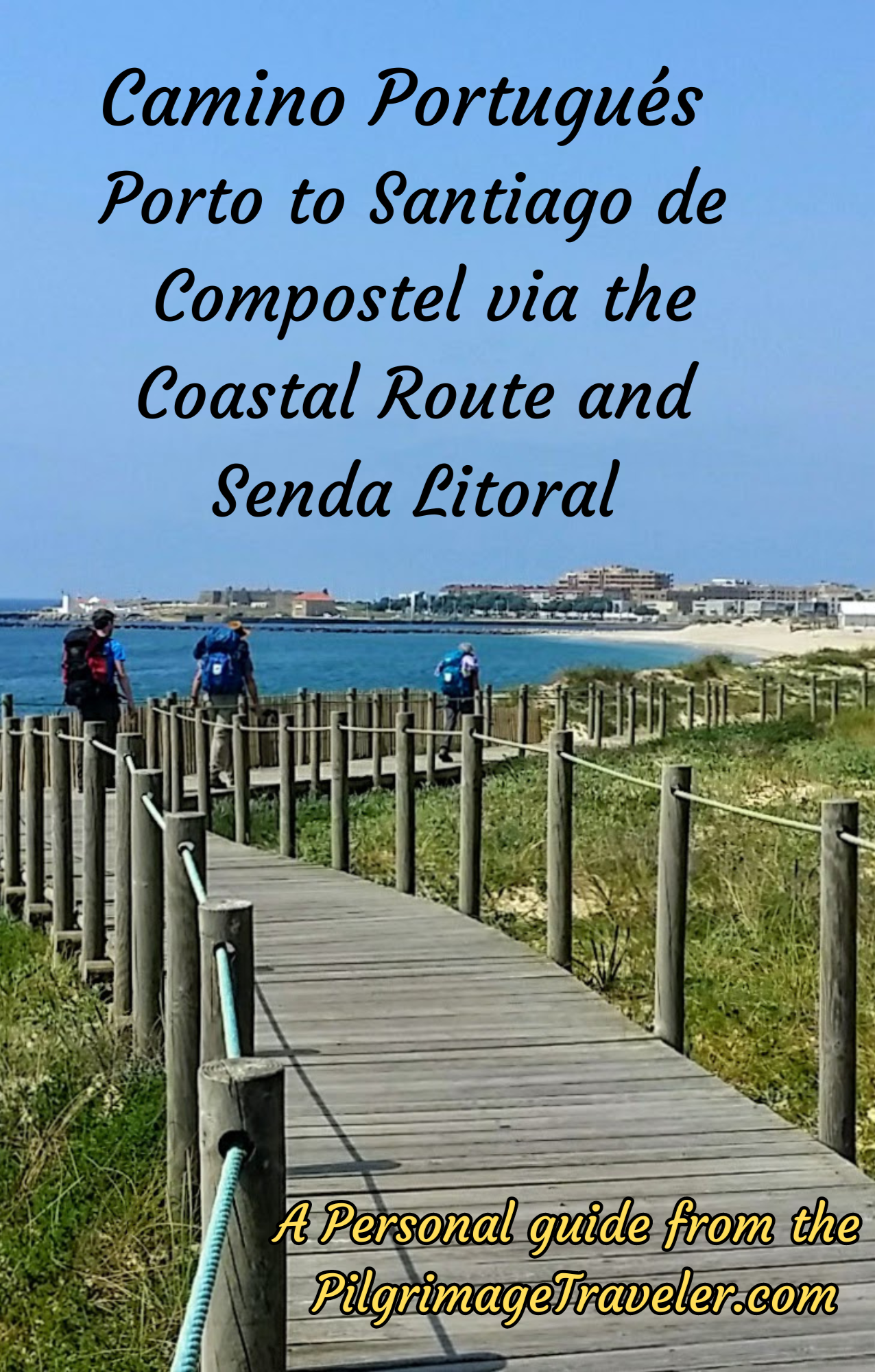
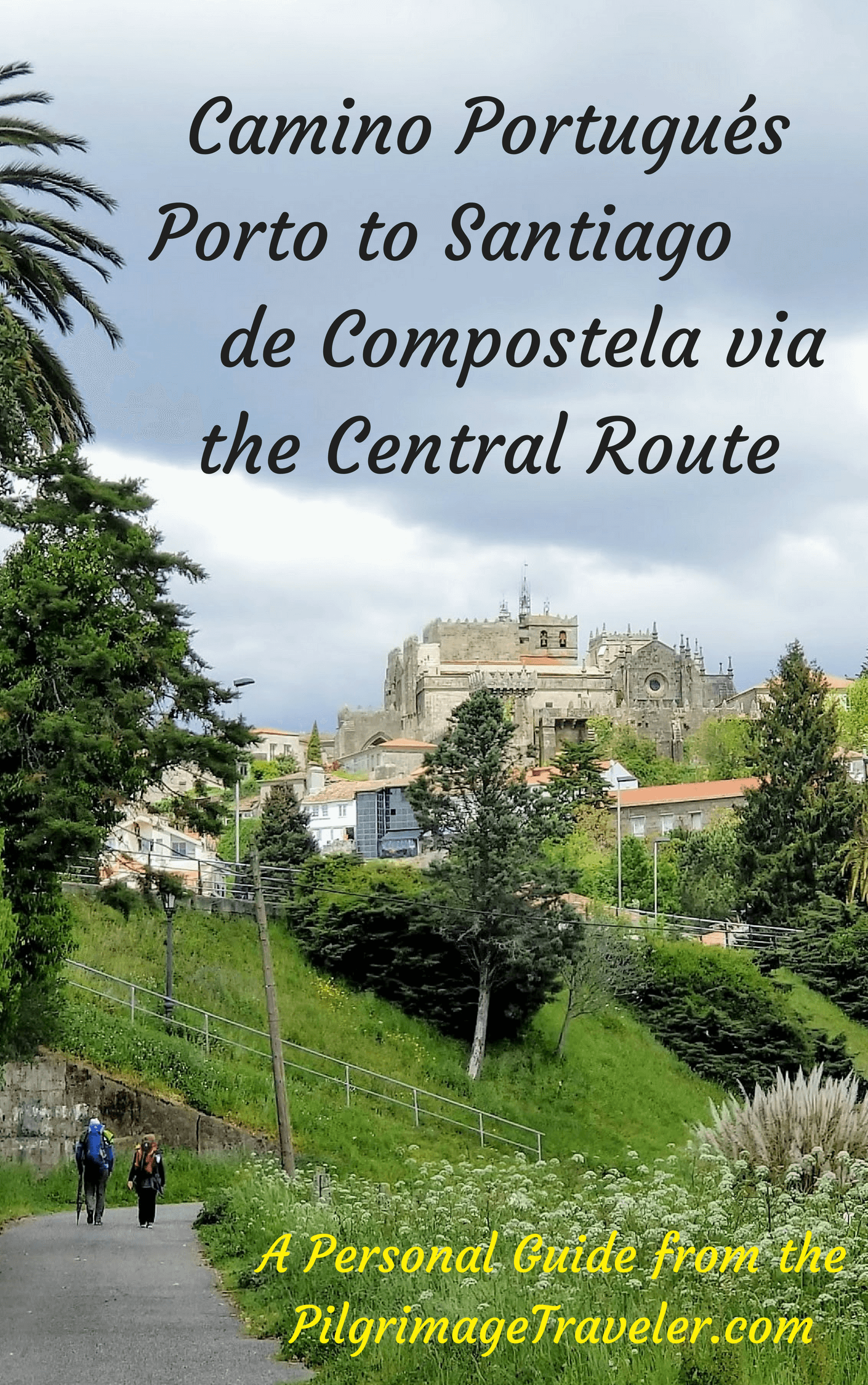
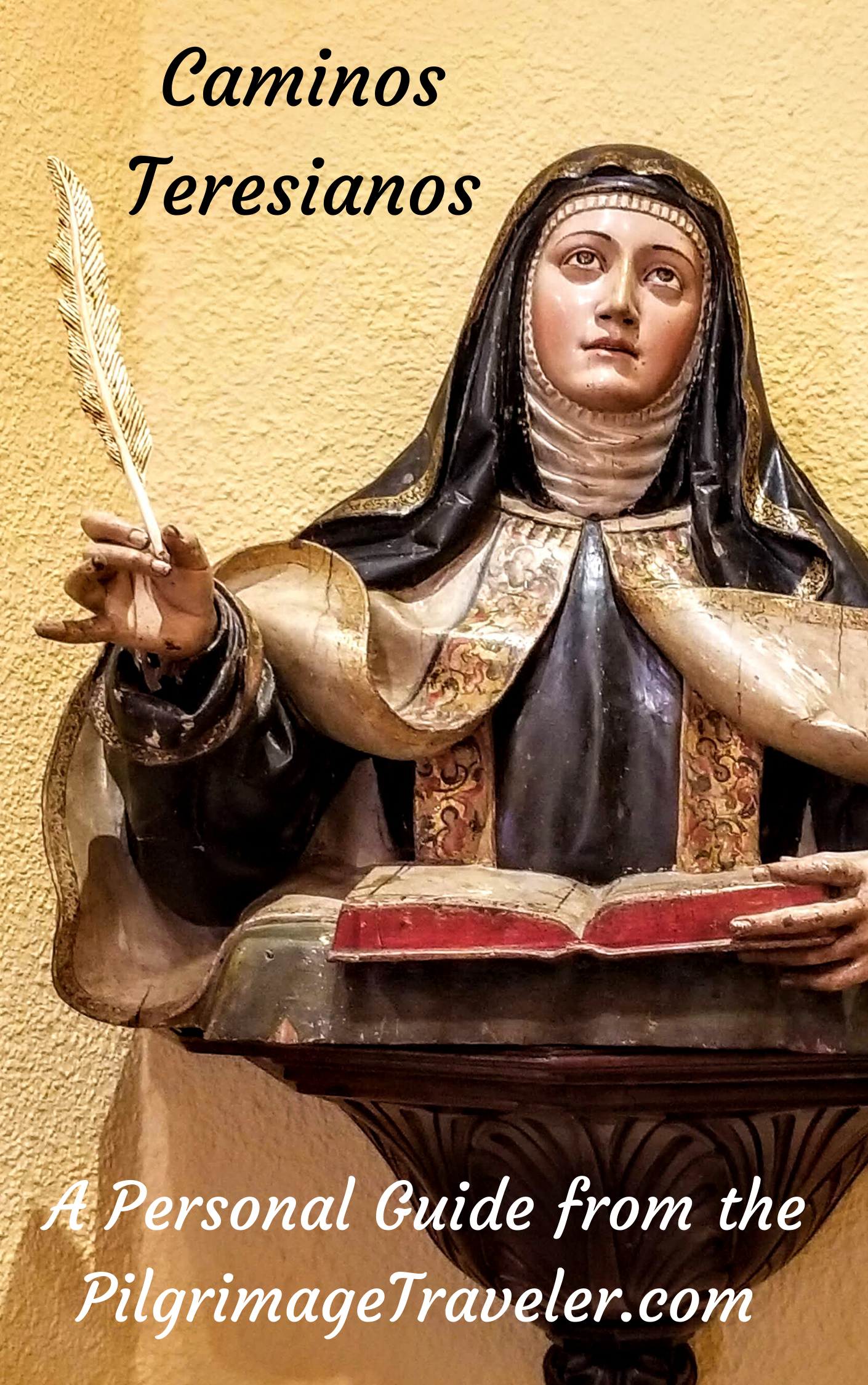
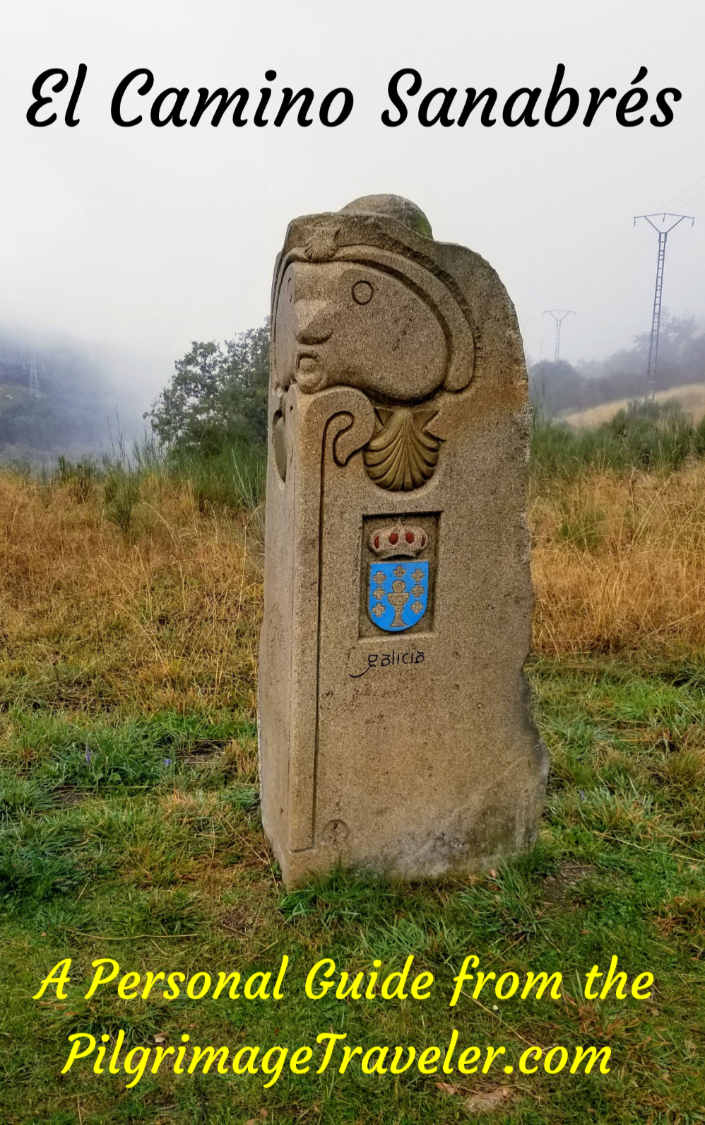
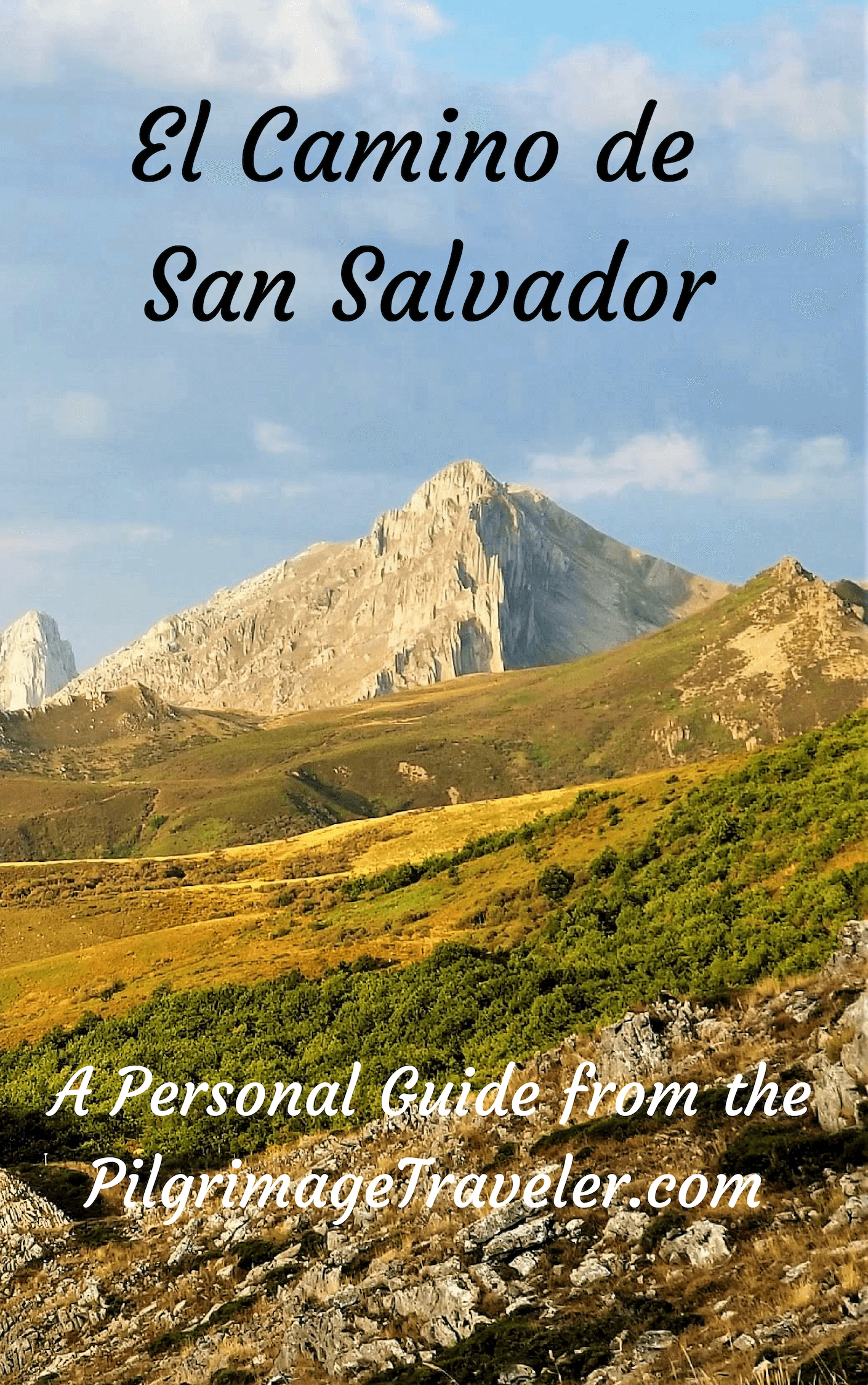
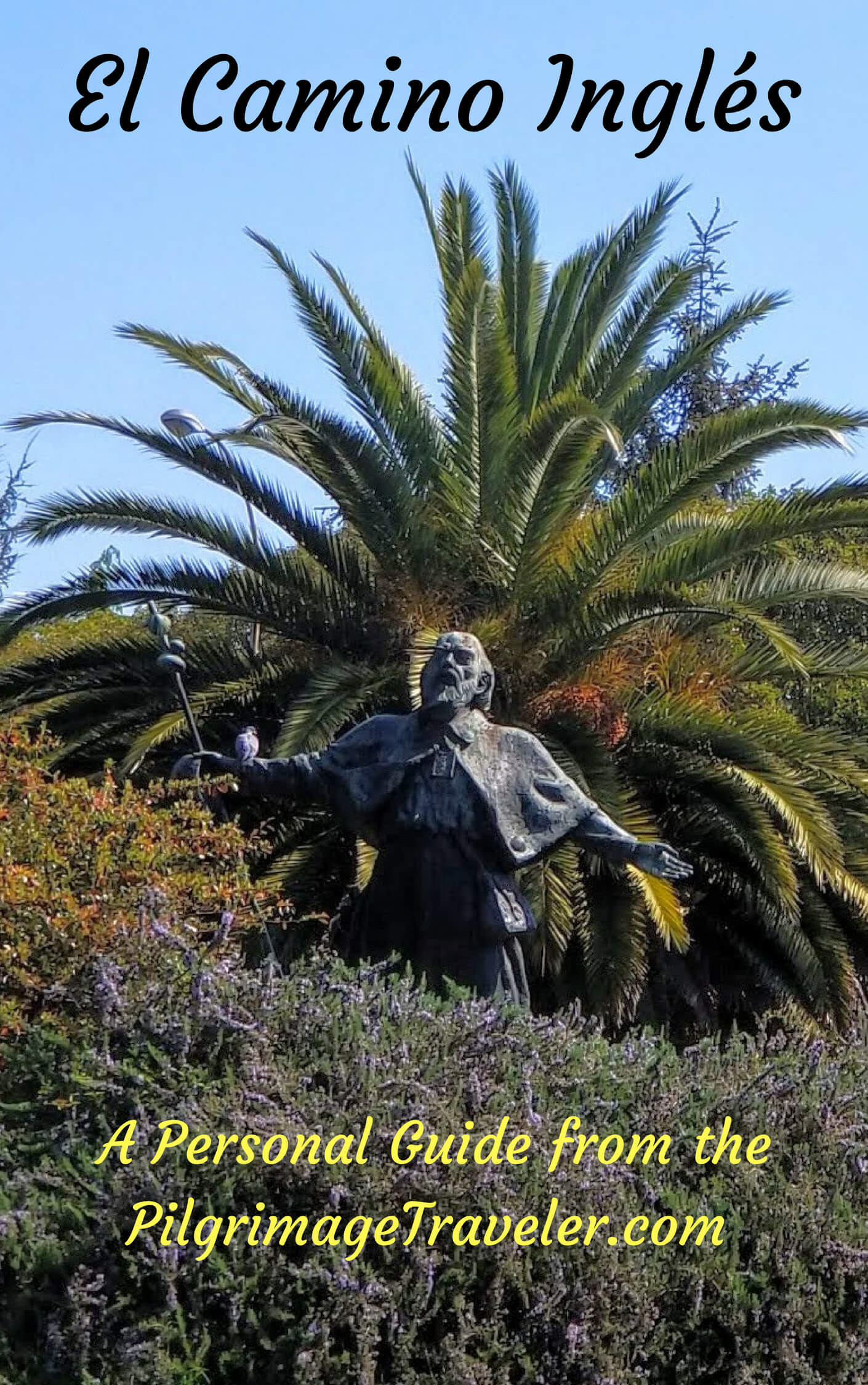
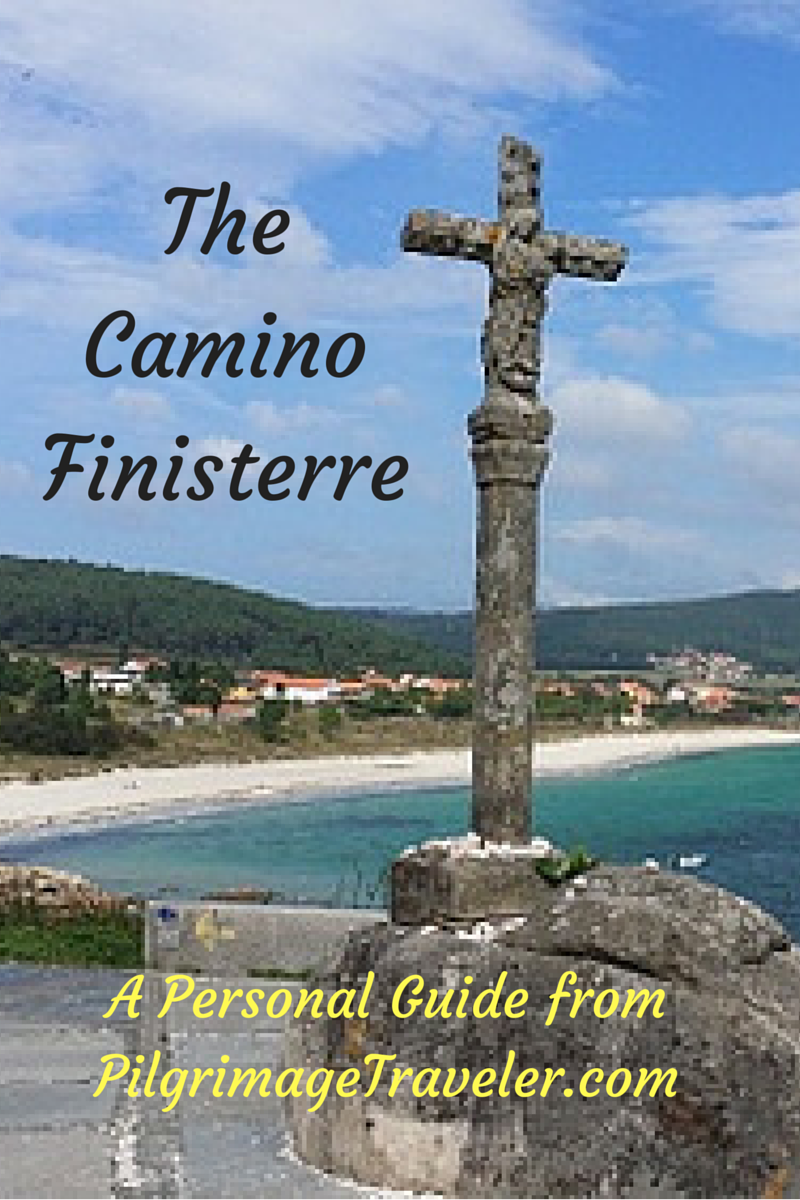
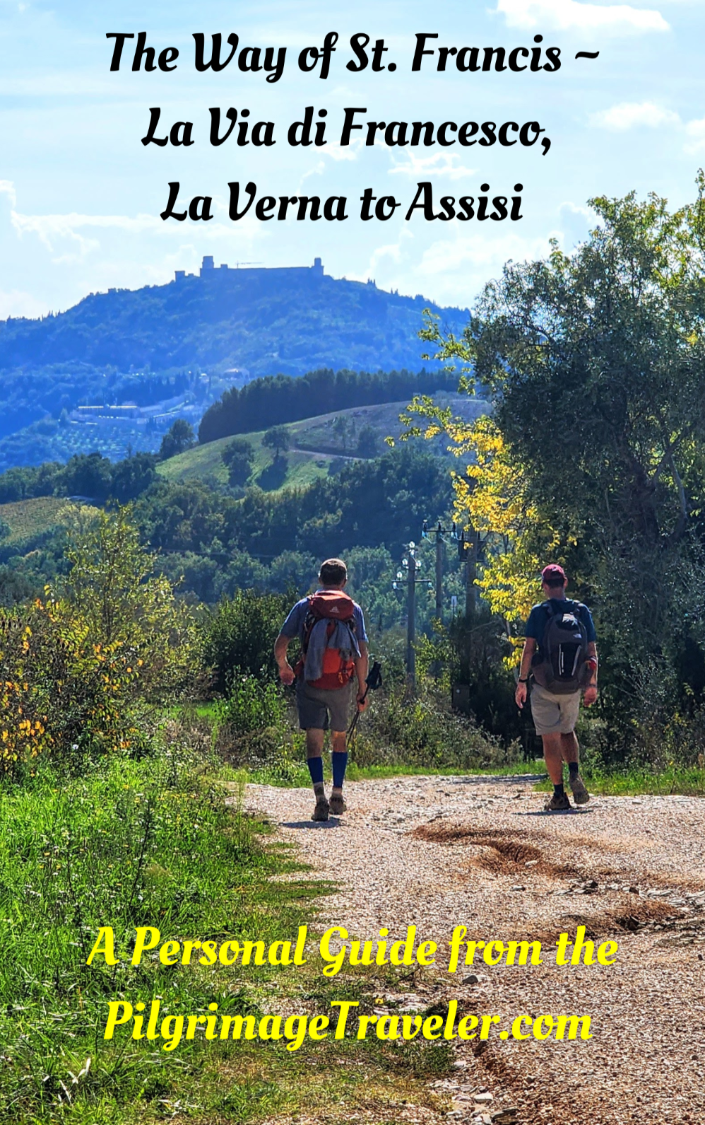

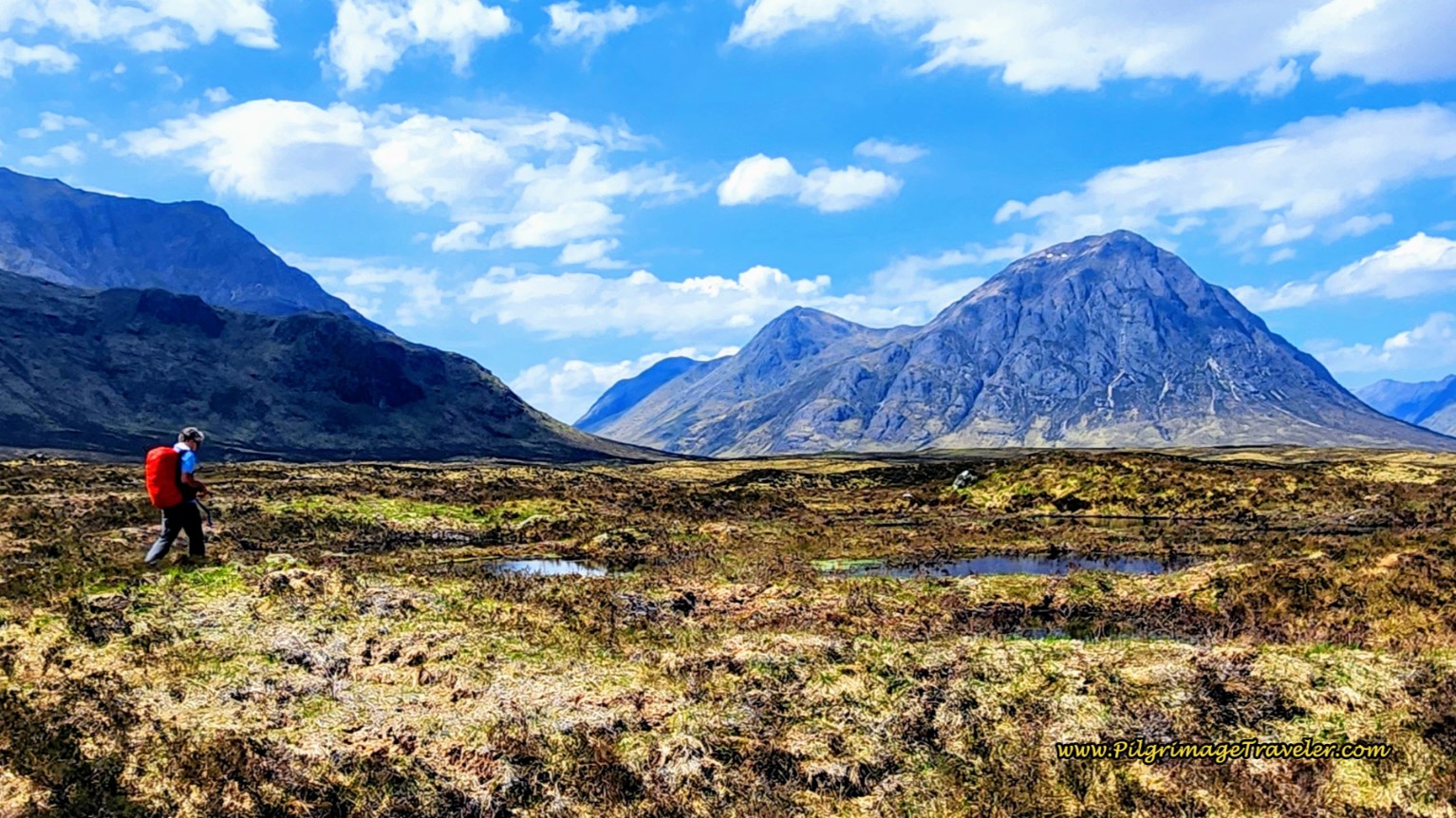
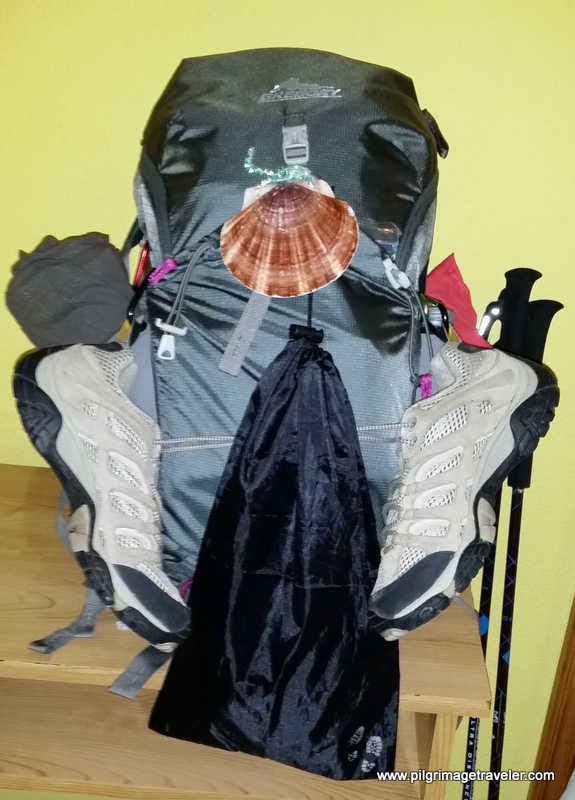
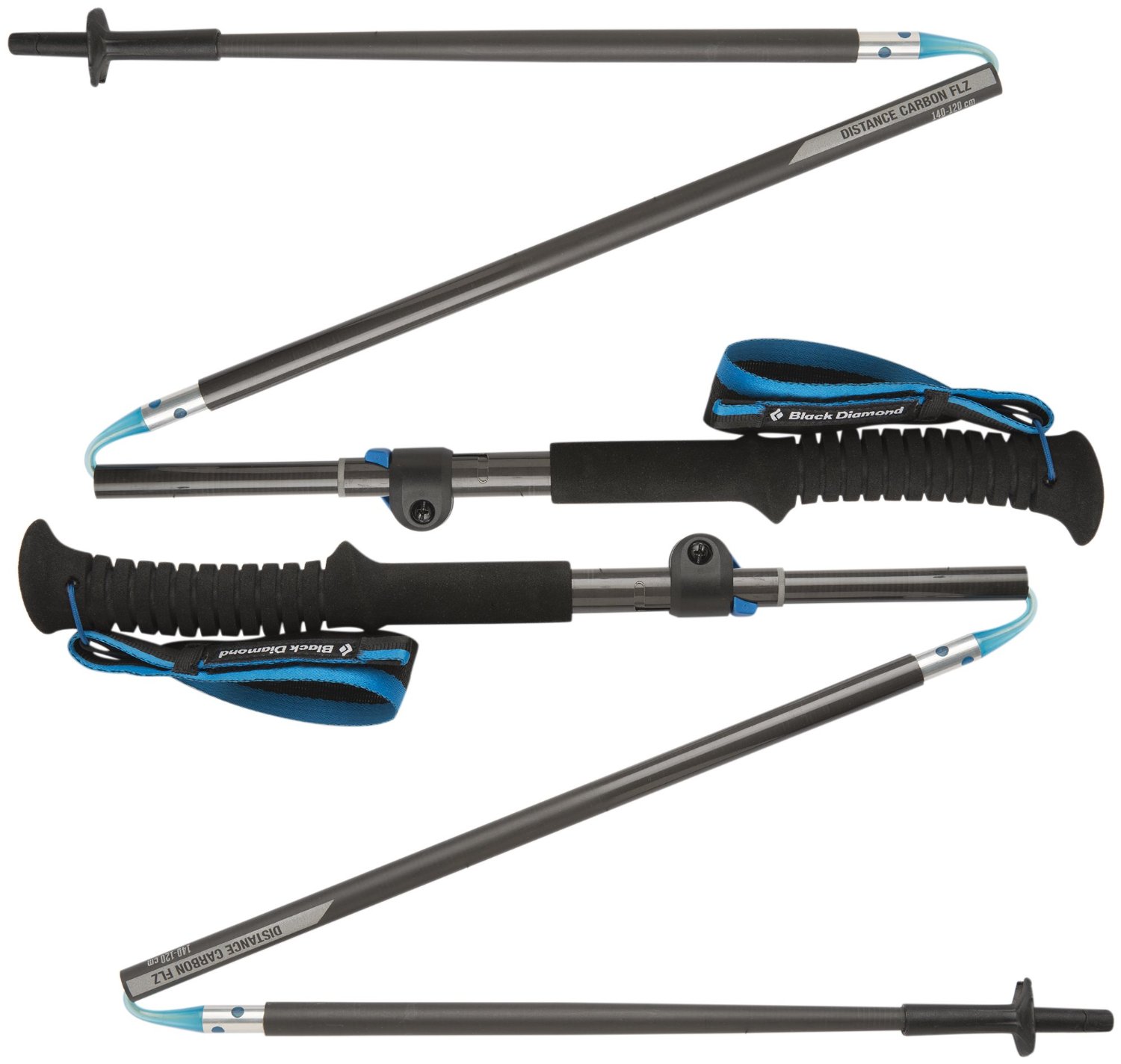


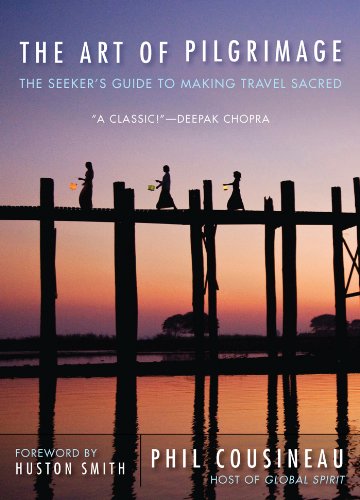


Your Opinion Matters! Comments
Have you had a similar experience, have some advice to give, or have something else you'd like to share? We would love to hear from you! Please leave us a comment in the box below.